Their reign is considered the golden age Stock Photos and Images
(20)See their reign is considered the golden age stock video clipsQuick filters:
Their reign is considered the golden age Stock Photos and Images
 Archduchess Isabella - Isabella Clara Eugenia of Habsburg (1566-1633), wife of Archduke Albertus of Austria Holland, The Netherlands, Dutch, ( Clara Isabella Eugenia, was sovereign of the Spanish Netherlands in the Low Countries and the north of modern France with her husband, Archduke Albert VII of Austria. Their reign is considered the Golden Age of the Spanish Netherlands. Isabella was one of the most powerful women in 16th- and 17th-century Europe.) Stock Photohttps://www.alamy.com/image-license-details/?v=1https://www.alamy.com/archduchess-isabella-isabella-clara-eugenia-of-habsburg-1566-1633-wife-of-archduke-albertus-of-austria-holland-the-netherlands-dutch-clara-isabella-eugenia-was-sovereign-of-the-spanish-netherlands-in-the-low-countries-and-the-north-of-modern-france-with-her-husband-archduke-albert-vii-of-austria-their-reign-is-considered-the-golden-age-of-the-spanish-netherlands-isabella-was-one-of-the-most-powerful-women-in-16th-and-17th-century-europe-image390843009.html
Archduchess Isabella - Isabella Clara Eugenia of Habsburg (1566-1633), wife of Archduke Albertus of Austria Holland, The Netherlands, Dutch, ( Clara Isabella Eugenia, was sovereign of the Spanish Netherlands in the Low Countries and the north of modern France with her husband, Archduke Albert VII of Austria. Their reign is considered the Golden Age of the Spanish Netherlands. Isabella was one of the most powerful women in 16th- and 17th-century Europe.) Stock Photohttps://www.alamy.com/image-license-details/?v=1https://www.alamy.com/archduchess-isabella-isabella-clara-eugenia-of-habsburg-1566-1633-wife-of-archduke-albertus-of-austria-holland-the-netherlands-dutch-clara-isabella-eugenia-was-sovereign-of-the-spanish-netherlands-in-the-low-countries-and-the-north-of-modern-france-with-her-husband-archduke-albert-vii-of-austria-their-reign-is-considered-the-golden-age-of-the-spanish-netherlands-isabella-was-one-of-the-most-powerful-women-in-16th-and-17th-century-europe-image390843009.htmlRM2DKTC6W–Archduchess Isabella - Isabella Clara Eugenia of Habsburg (1566-1633), wife of Archduke Albertus of Austria Holland, The Netherlands, Dutch, ( Clara Isabella Eugenia, was sovereign of the Spanish Netherlands in the Low Countries and the north of modern France with her husband, Archduke Albert VII of Austria. Their reign is considered the Golden Age of the Spanish Netherlands. Isabella was one of the most powerful women in 16th- and 17th-century Europe.)
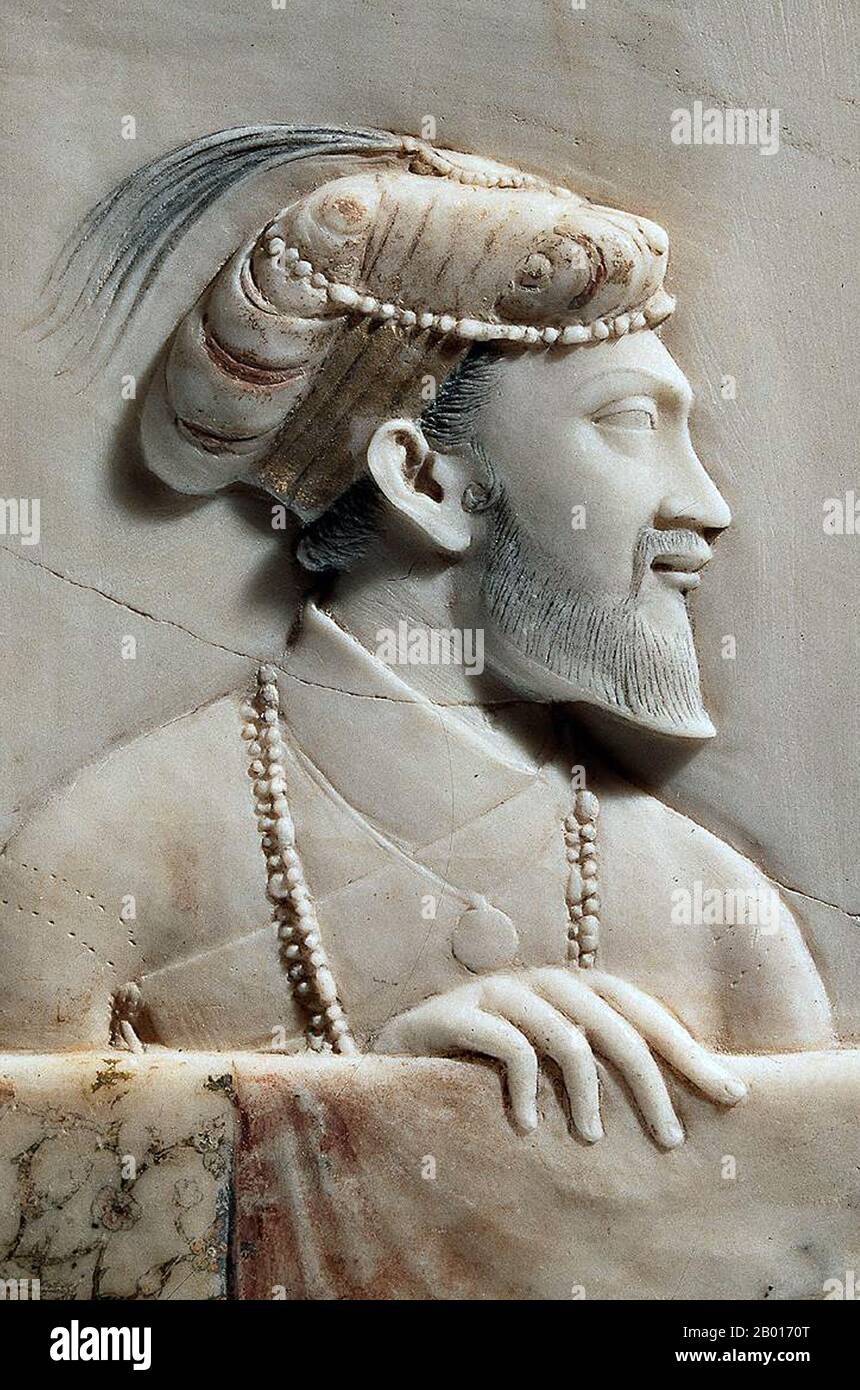 India: An alabaster portrait of Mughal emperor Shah Jahan (5 January 1592 - 22 January 1666), c. 1630. Shah Jahan was the emperor of the Mughal Empire in the Indian subcontinent from 1628 until 1658. The name Shah Jahan comes from the Persian meaning 'King of the World'. He was the fifth Mughal ruler after Babur, Humayun, Akbar, and Jahangir. While young, he was a favourite of his legendary grandfather Akbar the Great. He is also known as 'Shah Jahan the Magnificent'. The period of his reign is considered the golden age of Mughal expansion. Stock Photohttps://www.alamy.com/image-license-details/?v=1https://www.alamy.com/india-an-alabaster-portrait-of-mughal-emperor-shah-jahan-5-january-1592-22-january-1666-c-1630-shah-jahan-was-the-emperor-of-the-mughal-empire-in-the-indian-subcontinent-from-1628-until-1658-the-name-shah-jahan-comes-from-the-persian-meaning-king-of-the-world-he-was-the-fifth-mughal-ruler-after-babur-humayun-akbar-and-jahangir-while-young-he-was-a-favourite-of-his-legendary-grandfather-akbar-the-great-he-is-also-known-as-shah-jahan-the-magnificent-the-period-of-his-reign-is-considered-the-golden-age-of-mughal-expansion-image344234824.html
India: An alabaster portrait of Mughal emperor Shah Jahan (5 January 1592 - 22 January 1666), c. 1630. Shah Jahan was the emperor of the Mughal Empire in the Indian subcontinent from 1628 until 1658. The name Shah Jahan comes from the Persian meaning 'King of the World'. He was the fifth Mughal ruler after Babur, Humayun, Akbar, and Jahangir. While young, he was a favourite of his legendary grandfather Akbar the Great. He is also known as 'Shah Jahan the Magnificent'. The period of his reign is considered the golden age of Mughal expansion. Stock Photohttps://www.alamy.com/image-license-details/?v=1https://www.alamy.com/india-an-alabaster-portrait-of-mughal-emperor-shah-jahan-5-january-1592-22-january-1666-c-1630-shah-jahan-was-the-emperor-of-the-mughal-empire-in-the-indian-subcontinent-from-1628-until-1658-the-name-shah-jahan-comes-from-the-persian-meaning-king-of-the-world-he-was-the-fifth-mughal-ruler-after-babur-humayun-akbar-and-jahangir-while-young-he-was-a-favourite-of-his-legendary-grandfather-akbar-the-great-he-is-also-known-as-shah-jahan-the-magnificent-the-period-of-his-reign-is-considered-the-golden-age-of-mughal-expansion-image344234824.htmlRM2B0170T–India: An alabaster portrait of Mughal emperor Shah Jahan (5 January 1592 - 22 January 1666), c. 1630. Shah Jahan was the emperor of the Mughal Empire in the Indian subcontinent from 1628 until 1658. The name Shah Jahan comes from the Persian meaning 'King of the World'. He was the fifth Mughal ruler after Babur, Humayun, Akbar, and Jahangir. While young, he was a favourite of his legendary grandfather Akbar the Great. He is also known as 'Shah Jahan the Magnificent'. The period of his reign is considered the golden age of Mughal expansion.
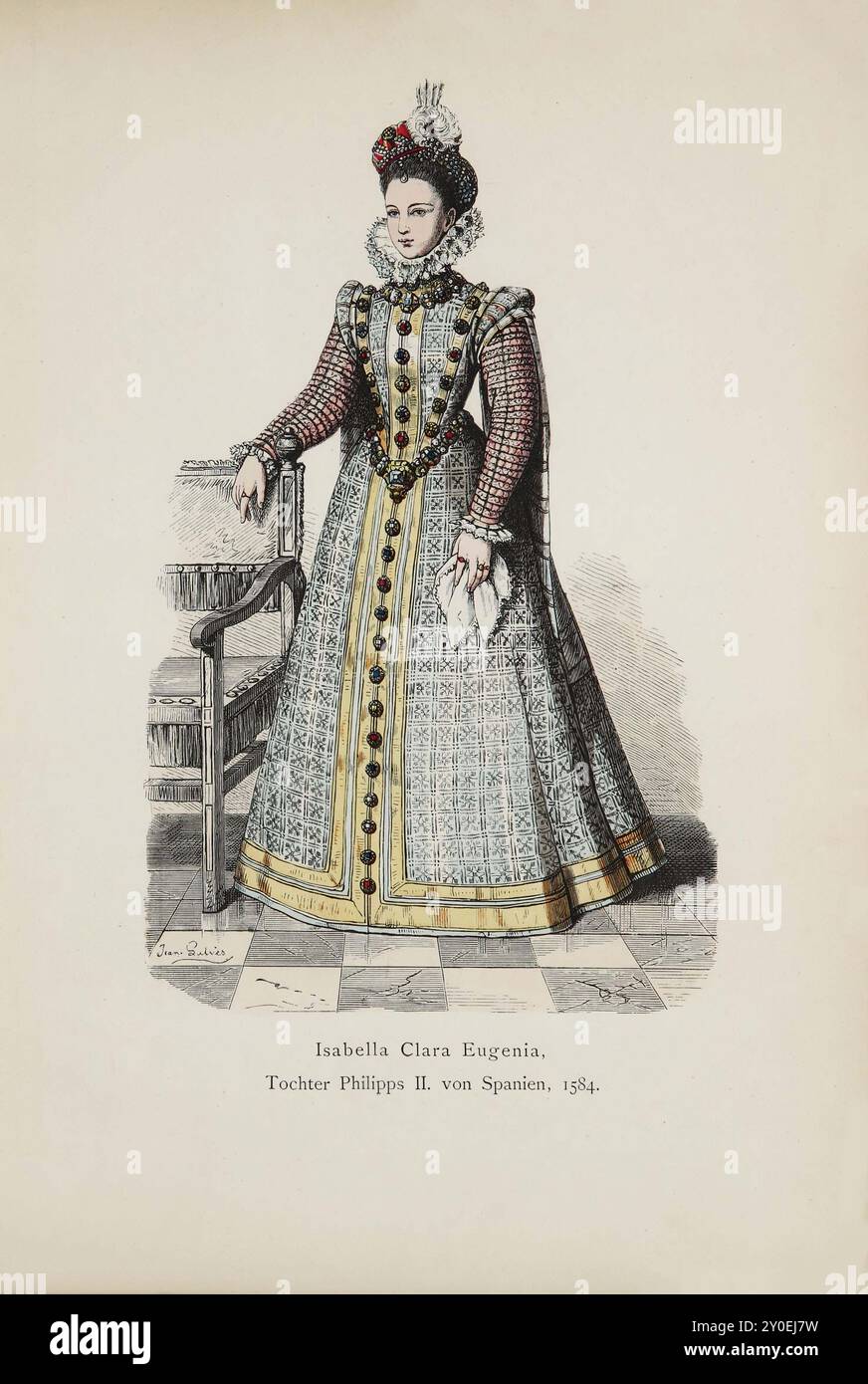 Historical and folk costumes of Europe. Isabella Clara Eugenia, daughter of Philip II of Spain, 1584 Isabella Clara Eugenia (Spanish: Isabel Clara Eugenia; 1566–1633) was sovereign of the Spanish Netherlands, which comprised the Low Countries and the north of modern France with her husband, Archduke Albert VII of Austria. Their reign is considered the Golden Age of the Spanish Netherlands, which saw a revival of its economy and arts after a peace was concluded with the break-away Dutch Republic. Isabella was one of the most powerful women in 16th- and 17th-century Europe. The dress with a hig Stock Photohttps://www.alamy.com/image-license-details/?v=1https://www.alamy.com/historical-and-folk-costumes-of-europe-isabella-clara-eugenia-daughter-of-philip-ii-of-spain-1584-isabella-clara-eugenia-spanish-isabel-clara-eugenia-15661633-was-sovereign-of-the-spanish-netherlands-which-comprised-the-low-countries-and-the-north-of-modern-france-with-her-husband-archduke-albert-vii-of-austria-their-reign-is-considered-the-golden-age-of-the-spanish-netherlands-which-saw-a-revival-of-its-economy-and-arts-after-a-peace-was-concluded-with-the-break-away-dutch-republic-isabella-was-one-of-the-most-powerful-women-in-16th-and-17th-century-europe-the-dress-with-a-hig-image619894909.html
Historical and folk costumes of Europe. Isabella Clara Eugenia, daughter of Philip II of Spain, 1584 Isabella Clara Eugenia (Spanish: Isabel Clara Eugenia; 1566–1633) was sovereign of the Spanish Netherlands, which comprised the Low Countries and the north of modern France with her husband, Archduke Albert VII of Austria. Their reign is considered the Golden Age of the Spanish Netherlands, which saw a revival of its economy and arts after a peace was concluded with the break-away Dutch Republic. Isabella was one of the most powerful women in 16th- and 17th-century Europe. The dress with a hig Stock Photohttps://www.alamy.com/image-license-details/?v=1https://www.alamy.com/historical-and-folk-costumes-of-europe-isabella-clara-eugenia-daughter-of-philip-ii-of-spain-1584-isabella-clara-eugenia-spanish-isabel-clara-eugenia-15661633-was-sovereign-of-the-spanish-netherlands-which-comprised-the-low-countries-and-the-north-of-modern-france-with-her-husband-archduke-albert-vii-of-austria-their-reign-is-considered-the-golden-age-of-the-spanish-netherlands-which-saw-a-revival-of-its-economy-and-arts-after-a-peace-was-concluded-with-the-break-away-dutch-republic-isabella-was-one-of-the-most-powerful-women-in-16th-and-17th-century-europe-the-dress-with-a-hig-image619894909.htmlRM2Y0EJ7W–Historical and folk costumes of Europe. Isabella Clara Eugenia, daughter of Philip II of Spain, 1584 Isabella Clara Eugenia (Spanish: Isabel Clara Eugenia; 1566–1633) was sovereign of the Spanish Netherlands, which comprised the Low Countries and the north of modern France with her husband, Archduke Albert VII of Austria. Their reign is considered the Golden Age of the Spanish Netherlands, which saw a revival of its economy and arts after a peace was concluded with the break-away Dutch Republic. Isabella was one of the most powerful women in 16th- and 17th-century Europe. The dress with a hig
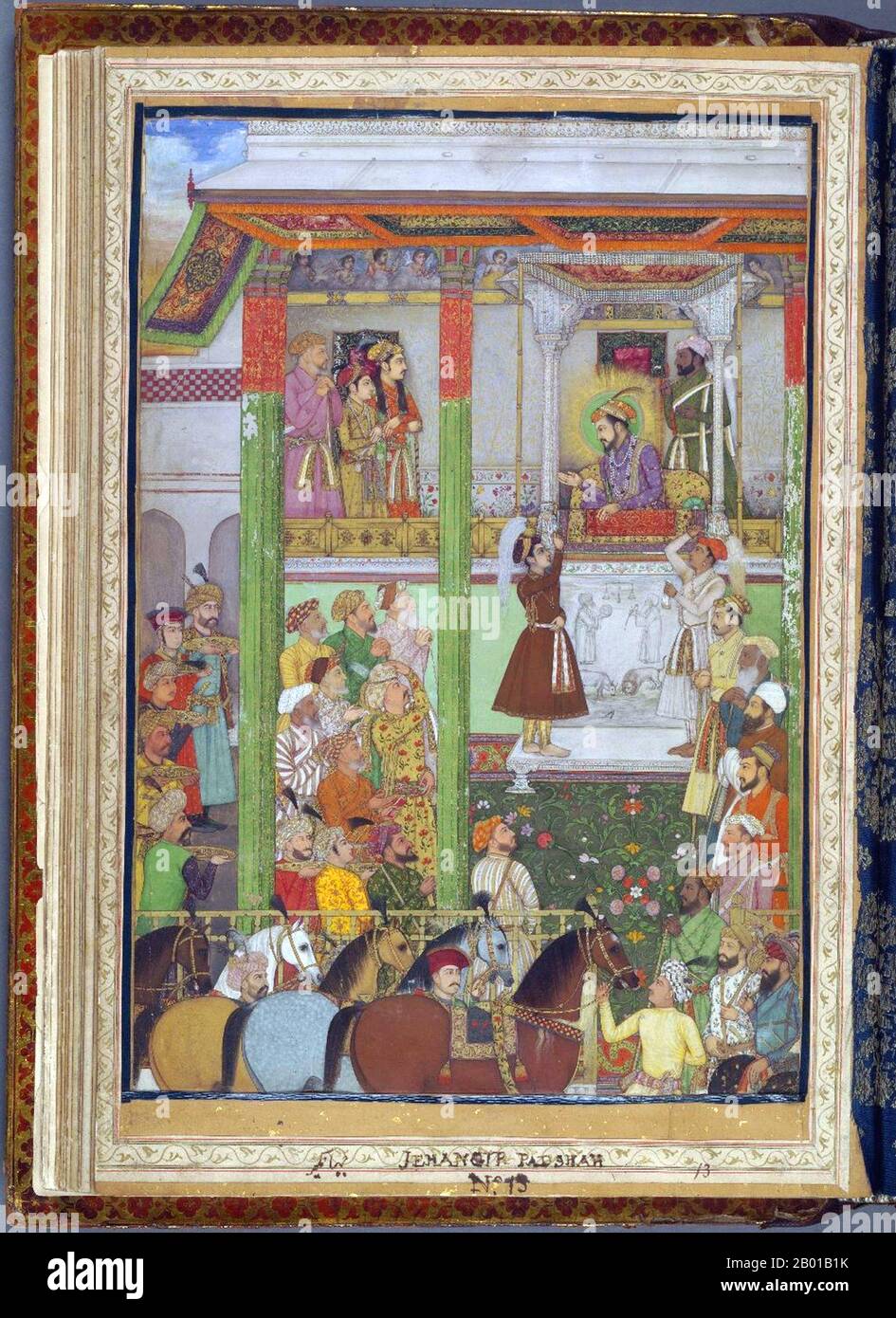 India: Emperor Shah Jahan (5 January 1592 - 22 January 1666) receives Ali Mardan Khan in his durbar (court). Miniature painting, c. 1640. Shah Jahan was the fifth emperor of the Mughal Empire, ruling from 1628 until 1658. The name Shah Jahan comes from the Persian meaning 'King of the World'. While young, he was a favourite of his legendary grandfather Akbar the Great. He is also known as 'Shah Jahan the Magnificent'. The period of his reign is considered the golden age of Mughal expansion; by the end of his reign the Mughal Empire covered 3 million square km and most of India. Stock Photohttps://www.alamy.com/image-license-details/?v=1https://www.alamy.com/india-emperor-shah-jahan-5-january-1592-22-january-1666-receives-ali-mardan-khan-in-his-durbar-court-miniature-painting-c-1640-shah-jahan-was-the-fifth-emperor-of-the-mughal-empire-ruling-from-1628-until-1658-the-name-shah-jahan-comes-from-the-persian-meaning-king-of-the-world-while-young-he-was-a-favourite-of-his-legendary-grandfather-akbar-the-great-he-is-also-known-as-shah-jahan-the-magnificent-the-period-of-his-reign-is-considered-the-golden-age-of-mughal-expansion-by-the-end-of-his-reign-the-mughal-empire-covered-3-million-square-km-and-most-of-india-image344237983.html
India: Emperor Shah Jahan (5 January 1592 - 22 January 1666) receives Ali Mardan Khan in his durbar (court). Miniature painting, c. 1640. Shah Jahan was the fifth emperor of the Mughal Empire, ruling from 1628 until 1658. The name Shah Jahan comes from the Persian meaning 'King of the World'. While young, he was a favourite of his legendary grandfather Akbar the Great. He is also known as 'Shah Jahan the Magnificent'. The period of his reign is considered the golden age of Mughal expansion; by the end of his reign the Mughal Empire covered 3 million square km and most of India. Stock Photohttps://www.alamy.com/image-license-details/?v=1https://www.alamy.com/india-emperor-shah-jahan-5-january-1592-22-january-1666-receives-ali-mardan-khan-in-his-durbar-court-miniature-painting-c-1640-shah-jahan-was-the-fifth-emperor-of-the-mughal-empire-ruling-from-1628-until-1658-the-name-shah-jahan-comes-from-the-persian-meaning-king-of-the-world-while-young-he-was-a-favourite-of-his-legendary-grandfather-akbar-the-great-he-is-also-known-as-shah-jahan-the-magnificent-the-period-of-his-reign-is-considered-the-golden-age-of-mughal-expansion-by-the-end-of-his-reign-the-mughal-empire-covered-3-million-square-km-and-most-of-india-image344237983.htmlRM2B01B1K–India: Emperor Shah Jahan (5 January 1592 - 22 January 1666) receives Ali Mardan Khan in his durbar (court). Miniature painting, c. 1640. Shah Jahan was the fifth emperor of the Mughal Empire, ruling from 1628 until 1658. The name Shah Jahan comes from the Persian meaning 'King of the World'. While young, he was a favourite of his legendary grandfather Akbar the Great. He is also known as 'Shah Jahan the Magnificent'. The period of his reign is considered the golden age of Mughal expansion; by the end of his reign the Mughal Empire covered 3 million square km and most of India.
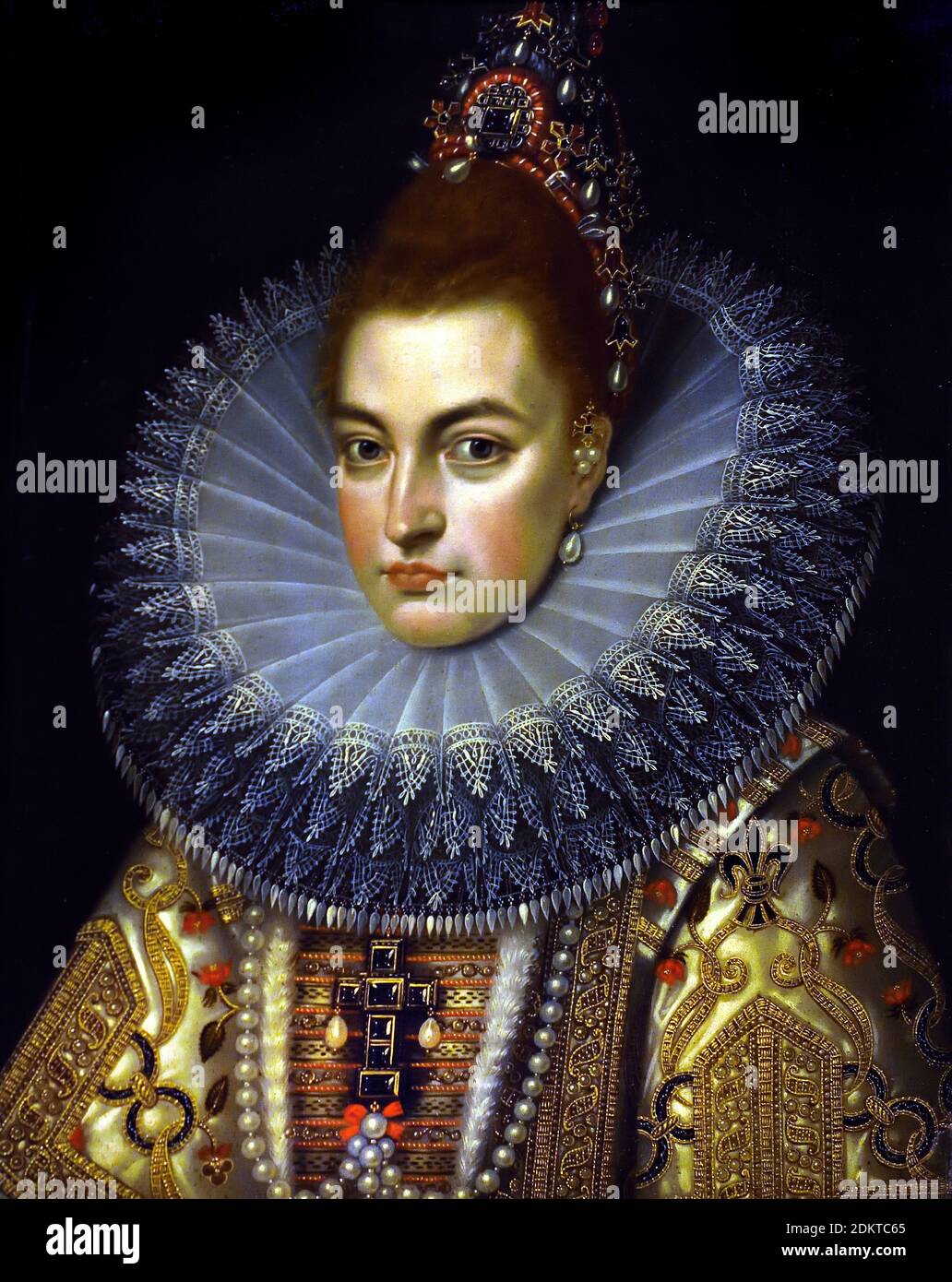 Archduchess Isabella - Isabella Clara Eugenia of Habsburg (1566-1633), wife of Archduke Albertus of Austria Holland, The Netherlands, Dutch, ( Clara Isabella Eugenia, was sovereign of the Spanish Netherlands in the Low Countries and the north of modern France with her husband, Archduke Albert VII of Austria. Their reign is considered the Golden Age of the Spanish Netherlands. Isabella was one of the most powerful women in 16th- and 17th-century Europe.) Stock Photohttps://www.alamy.com/image-license-details/?v=1https://www.alamy.com/archduchess-isabella-isabella-clara-eugenia-of-habsburg-1566-1633-wife-of-archduke-albertus-of-austria-holland-the-netherlands-dutch-clara-isabella-eugenia-was-sovereign-of-the-spanish-netherlands-in-the-low-countries-and-the-north-of-modern-france-with-her-husband-archduke-albert-vii-of-austria-their-reign-is-considered-the-golden-age-of-the-spanish-netherlands-isabella-was-one-of-the-most-powerful-women-in-16th-and-17th-century-europe-image390842989.html
Archduchess Isabella - Isabella Clara Eugenia of Habsburg (1566-1633), wife of Archduke Albertus of Austria Holland, The Netherlands, Dutch, ( Clara Isabella Eugenia, was sovereign of the Spanish Netherlands in the Low Countries and the north of modern France with her husband, Archduke Albert VII of Austria. Their reign is considered the Golden Age of the Spanish Netherlands. Isabella was one of the most powerful women in 16th- and 17th-century Europe.) Stock Photohttps://www.alamy.com/image-license-details/?v=1https://www.alamy.com/archduchess-isabella-isabella-clara-eugenia-of-habsburg-1566-1633-wife-of-archduke-albertus-of-austria-holland-the-netherlands-dutch-clara-isabella-eugenia-was-sovereign-of-the-spanish-netherlands-in-the-low-countries-and-the-north-of-modern-france-with-her-husband-archduke-albert-vii-of-austria-their-reign-is-considered-the-golden-age-of-the-spanish-netherlands-isabella-was-one-of-the-most-powerful-women-in-16th-and-17th-century-europe-image390842989.htmlRM2DKTC65–Archduchess Isabella - Isabella Clara Eugenia of Habsburg (1566-1633), wife of Archduke Albertus of Austria Holland, The Netherlands, Dutch, ( Clara Isabella Eugenia, was sovereign of the Spanish Netherlands in the Low Countries and the north of modern France with her husband, Archduke Albert VII of Austria. Their reign is considered the Golden Age of the Spanish Netherlands. Isabella was one of the most powerful women in 16th- and 17th-century Europe.)
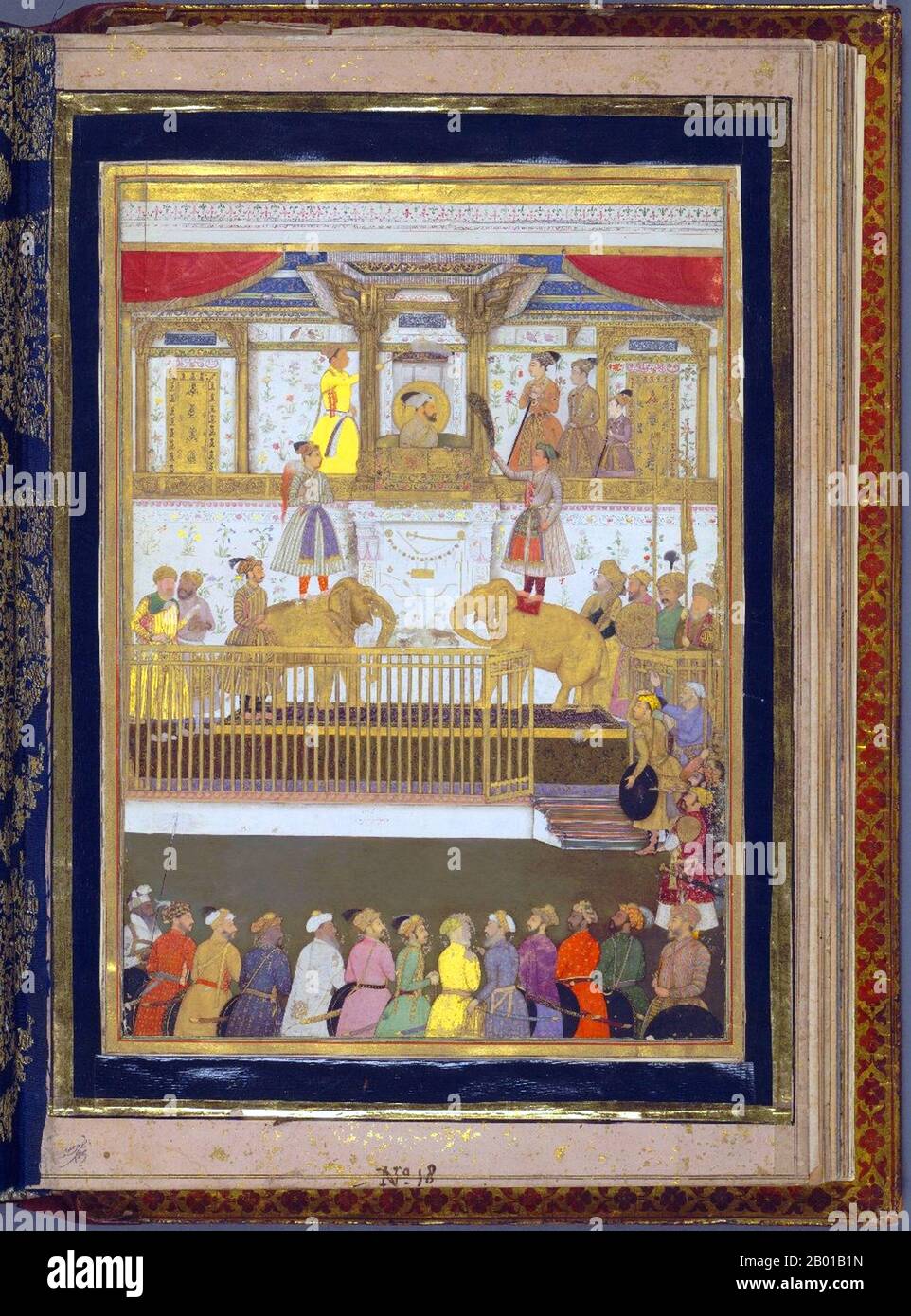 India: Shah Jahan (5 January 1592 - 22 January 1666) and his court, showing the emperor on a balcony, fanned by attendants standing on gilded elephants. Watercolour painting by Muhammad Ikhlas i Abid (fl. 18th century), 18th century. Shah Jahan was the fifth emperor of the Mughal Empire, ruling from 1628 until 1658. The name Shah Jahan comes from the Persian meaning 'King of the World'. While young, he was a favourite of his legendary grandfather Akbar the Great. He is also known as 'Shah Jahan the Magnificent'. The period of his reign is considered the golden age of Mughal expansion. Stock Photohttps://www.alamy.com/image-license-details/?v=1https://www.alamy.com/india-shah-jahan-5-january-1592-22-january-1666-and-his-court-showing-the-emperor-on-a-balcony-fanned-by-attendants-standing-on-gilded-elephants-watercolour-painting-by-muhammad-ikhlas-i-abid-fl-18th-century-18th-century-shah-jahan-was-the-fifth-emperor-of-the-mughal-empire-ruling-from-1628-until-1658-the-name-shah-jahan-comes-from-the-persian-meaning-king-of-the-world-while-young-he-was-a-favourite-of-his-legendary-grandfather-akbar-the-great-he-is-also-known-as-shah-jahan-the-magnificent-the-period-of-his-reign-is-considered-the-golden-age-of-mughal-expansion-image344237985.html
India: Shah Jahan (5 January 1592 - 22 January 1666) and his court, showing the emperor on a balcony, fanned by attendants standing on gilded elephants. Watercolour painting by Muhammad Ikhlas i Abid (fl. 18th century), 18th century. Shah Jahan was the fifth emperor of the Mughal Empire, ruling from 1628 until 1658. The name Shah Jahan comes from the Persian meaning 'King of the World'. While young, he was a favourite of his legendary grandfather Akbar the Great. He is also known as 'Shah Jahan the Magnificent'. The period of his reign is considered the golden age of Mughal expansion. Stock Photohttps://www.alamy.com/image-license-details/?v=1https://www.alamy.com/india-shah-jahan-5-january-1592-22-january-1666-and-his-court-showing-the-emperor-on-a-balcony-fanned-by-attendants-standing-on-gilded-elephants-watercolour-painting-by-muhammad-ikhlas-i-abid-fl-18th-century-18th-century-shah-jahan-was-the-fifth-emperor-of-the-mughal-empire-ruling-from-1628-until-1658-the-name-shah-jahan-comes-from-the-persian-meaning-king-of-the-world-while-young-he-was-a-favourite-of-his-legendary-grandfather-akbar-the-great-he-is-also-known-as-shah-jahan-the-magnificent-the-period-of-his-reign-is-considered-the-golden-age-of-mughal-expansion-image344237985.htmlRM2B01B1N–India: Shah Jahan (5 January 1592 - 22 January 1666) and his court, showing the emperor on a balcony, fanned by attendants standing on gilded elephants. Watercolour painting by Muhammad Ikhlas i Abid (fl. 18th century), 18th century. Shah Jahan was the fifth emperor of the Mughal Empire, ruling from 1628 until 1658. The name Shah Jahan comes from the Persian meaning 'King of the World'. While young, he was a favourite of his legendary grandfather Akbar the Great. He is also known as 'Shah Jahan the Magnificent'. The period of his reign is considered the golden age of Mughal expansion.
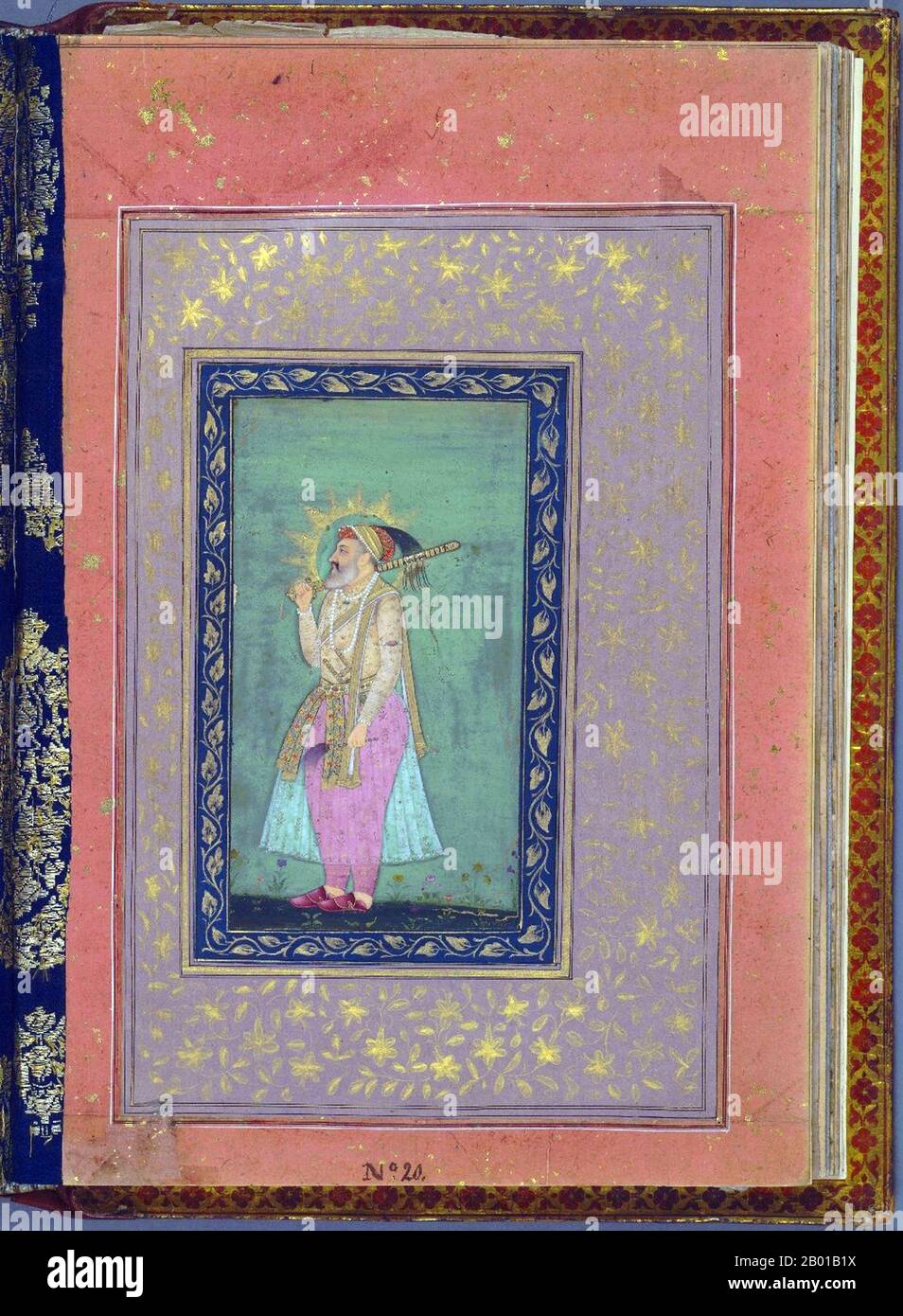 India: Mughal Royal Lineage - Emperor Shah Jahan (5 January 1592 - 22 January 1666). Miniature painting, c. 1640. Shahanshah Shahab-ud-din Muhammad Shah Jahan I was the fifth emperor of the Mughal Empire, ruling from 1628 until 1658. The name Shah Jahan comes from the Persian meaning 'King of the World'. While young, he was a favourite of his legendary grandfather Akbar the Great. He is also known as 'Shah Jahan the Magnificent'. The period of his reign is considered the golden age of Mughal expansion; by the end of his reign the Mughal Empire covered 3 million square km and most of India. Stock Photohttps://www.alamy.com/image-license-details/?v=1https://www.alamy.com/india-mughal-royal-lineage-emperor-shah-jahan-5-january-1592-22-january-1666-miniature-painting-c-1640-shahanshah-shahab-ud-din-muhammad-shah-jahan-i-was-the-fifth-emperor-of-the-mughal-empire-ruling-from-1628-until-1658-the-name-shah-jahan-comes-from-the-persian-meaning-king-of-the-world-while-young-he-was-a-favourite-of-his-legendary-grandfather-akbar-the-great-he-is-also-known-as-shah-jahan-the-magnificent-the-period-of-his-reign-is-considered-the-golden-age-of-mughal-expansion-by-the-end-of-his-reign-the-mughal-empire-covered-3-million-square-km-and-most-of-india-image344237990.html
India: Mughal Royal Lineage - Emperor Shah Jahan (5 January 1592 - 22 January 1666). Miniature painting, c. 1640. Shahanshah Shahab-ud-din Muhammad Shah Jahan I was the fifth emperor of the Mughal Empire, ruling from 1628 until 1658. The name Shah Jahan comes from the Persian meaning 'King of the World'. While young, he was a favourite of his legendary grandfather Akbar the Great. He is also known as 'Shah Jahan the Magnificent'. The period of his reign is considered the golden age of Mughal expansion; by the end of his reign the Mughal Empire covered 3 million square km and most of India. Stock Photohttps://www.alamy.com/image-license-details/?v=1https://www.alamy.com/india-mughal-royal-lineage-emperor-shah-jahan-5-january-1592-22-january-1666-miniature-painting-c-1640-shahanshah-shahab-ud-din-muhammad-shah-jahan-i-was-the-fifth-emperor-of-the-mughal-empire-ruling-from-1628-until-1658-the-name-shah-jahan-comes-from-the-persian-meaning-king-of-the-world-while-young-he-was-a-favourite-of-his-legendary-grandfather-akbar-the-great-he-is-also-known-as-shah-jahan-the-magnificent-the-period-of-his-reign-is-considered-the-golden-age-of-mughal-expansion-by-the-end-of-his-reign-the-mughal-empire-covered-3-million-square-km-and-most-of-india-image344237990.htmlRM2B01B1X–India: Mughal Royal Lineage - Emperor Shah Jahan (5 January 1592 - 22 January 1666). Miniature painting, c. 1640. Shahanshah Shahab-ud-din Muhammad Shah Jahan I was the fifth emperor of the Mughal Empire, ruling from 1628 until 1658. The name Shah Jahan comes from the Persian meaning 'King of the World'. While young, he was a favourite of his legendary grandfather Akbar the Great. He is also known as 'Shah Jahan the Magnificent'. The period of his reign is considered the golden age of Mughal expansion; by the end of his reign the Mughal Empire covered 3 million square km and most of India.
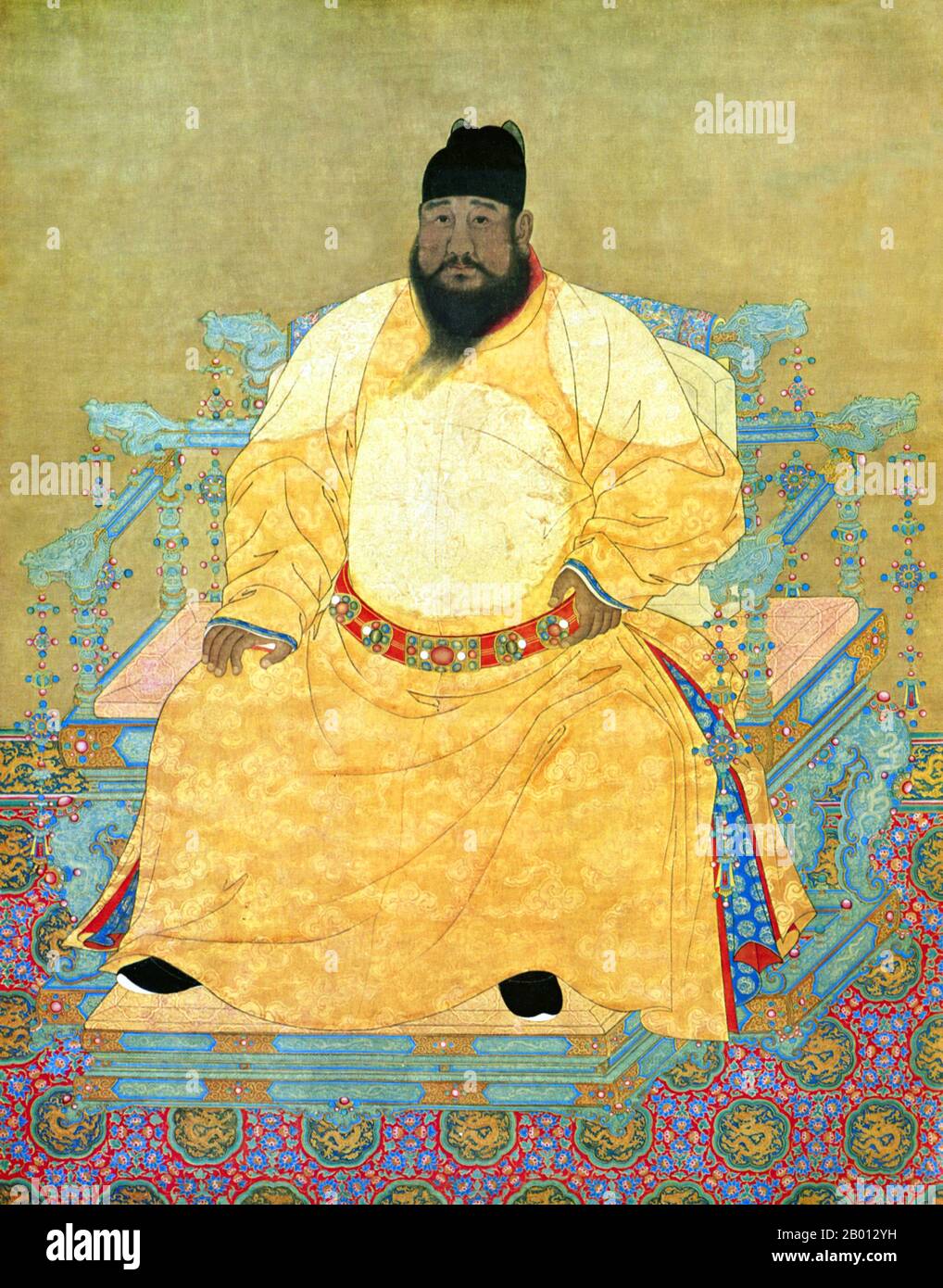 China: Emperor Xuande, 5th ruler of the Ming Dynasty (r. 1425-1435). Hanging scroll painting, 15th-17th century. The Xuande Emperor (1399-1435), personal name Zhu Zhani and temple name Xuanzong, was the 5th emperor of Ming China. His era name means 'Proclamation of Virtue'. The Xuande Emperor ruled over a remarkably peaceful time with no significant external or internal problems. Later historians have considered his reign to be the Ming dynasty's golden age. Stock Photohttps://www.alamy.com/image-license-details/?v=1https://www.alamy.com/china-emperor-xuande-5th-ruler-of-the-ming-dynasty-r-1425-1435-hanging-scroll-painting-15th-17th-century-the-xuande-emperor-1399-1435-personal-name-zhu-zhani-and-temple-name-xuanzong-was-the-5th-emperor-of-ming-china-his-era-name-means-proclamation-of-virtue-the-xuande-emperor-ruled-over-a-remarkably-peaceful-time-with-no-significant-external-or-internal-problems-later-historians-have-considered-his-reign-to-be-the-ming-dynastys-golden-age-image344231653.html
China: Emperor Xuande, 5th ruler of the Ming Dynasty (r. 1425-1435). Hanging scroll painting, 15th-17th century. The Xuande Emperor (1399-1435), personal name Zhu Zhani and temple name Xuanzong, was the 5th emperor of Ming China. His era name means 'Proclamation of Virtue'. The Xuande Emperor ruled over a remarkably peaceful time with no significant external or internal problems. Later historians have considered his reign to be the Ming dynasty's golden age. Stock Photohttps://www.alamy.com/image-license-details/?v=1https://www.alamy.com/china-emperor-xuande-5th-ruler-of-the-ming-dynasty-r-1425-1435-hanging-scroll-painting-15th-17th-century-the-xuande-emperor-1399-1435-personal-name-zhu-zhani-and-temple-name-xuanzong-was-the-5th-emperor-of-ming-china-his-era-name-means-proclamation-of-virtue-the-xuande-emperor-ruled-over-a-remarkably-peaceful-time-with-no-significant-external-or-internal-problems-later-historians-have-considered-his-reign-to-be-the-ming-dynastys-golden-age-image344231653.htmlRM2B012YH–China: Emperor Xuande, 5th ruler of the Ming Dynasty (r. 1425-1435). Hanging scroll painting, 15th-17th century. The Xuande Emperor (1399-1435), personal name Zhu Zhani and temple name Xuanzong, was the 5th emperor of Ming China. His era name means 'Proclamation of Virtue'. The Xuande Emperor ruled over a remarkably peaceful time with no significant external or internal problems. Later historians have considered his reign to be the Ming dynasty's golden age.
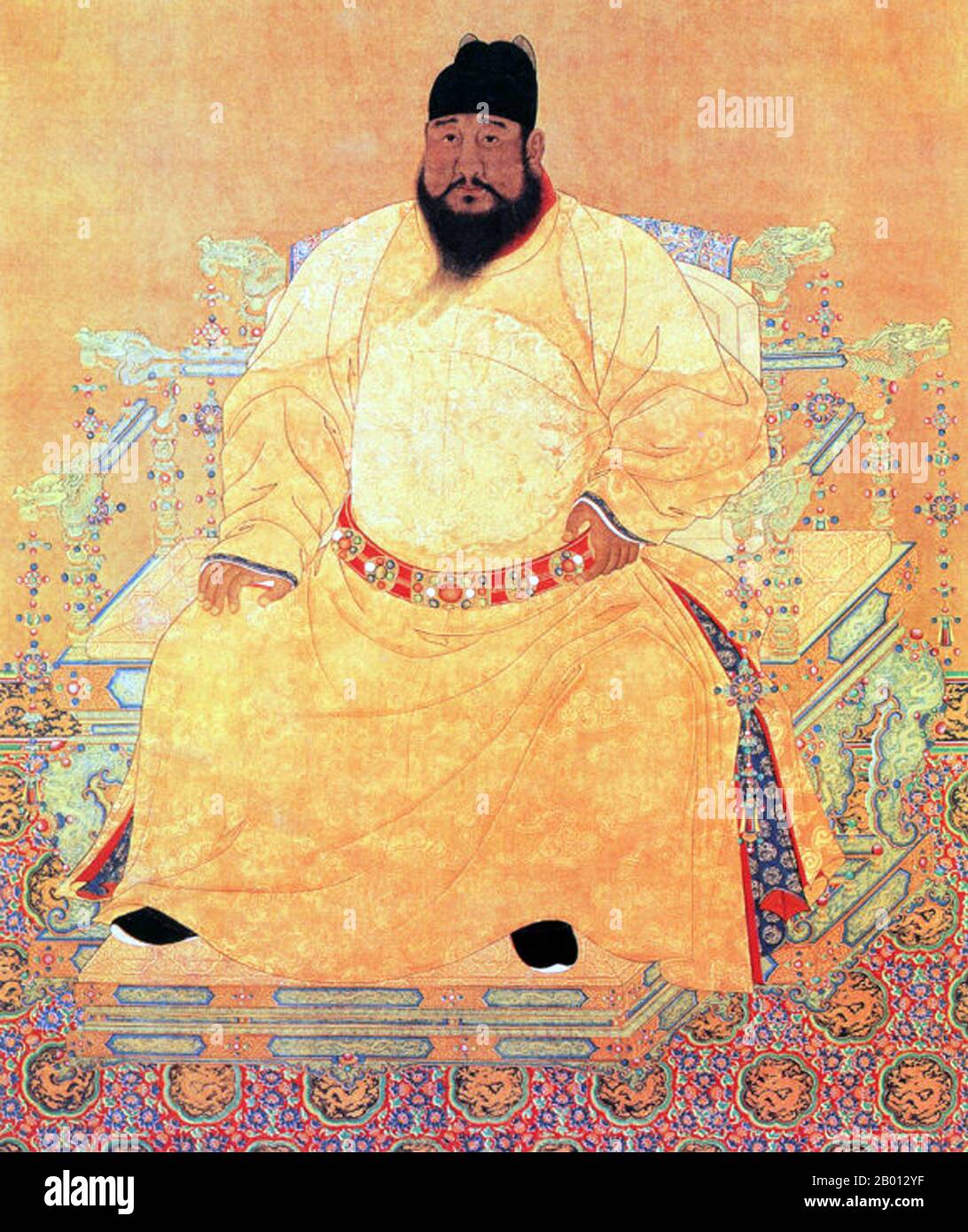 China: Emperor Xuande, 5th ruler of the Ming Dynasty (r. 1425-1435). Hanging scroll painting, 15th-17th century. The Xuande Emperor (1399-1435), personal name Zhu Zhani and temple name Xuanzong, was the 5th emperor of Ming China. His era name means 'Proclamation of Virtue'. The Xuande Emperor ruled over a remarkably peaceful time with no significant external or internal problems. Later historians have considered his reign to be the Ming dynasty's golden age. Stock Photohttps://www.alamy.com/image-license-details/?v=1https://www.alamy.com/china-emperor-xuande-5th-ruler-of-the-ming-dynasty-r-1425-1435-hanging-scroll-painting-15th-17th-century-the-xuande-emperor-1399-1435-personal-name-zhu-zhani-and-temple-name-xuanzong-was-the-5th-emperor-of-ming-china-his-era-name-means-proclamation-of-virtue-the-xuande-emperor-ruled-over-a-remarkably-peaceful-time-with-no-significant-external-or-internal-problems-later-historians-have-considered-his-reign-to-be-the-ming-dynastys-golden-age-image344231651.html
China: Emperor Xuande, 5th ruler of the Ming Dynasty (r. 1425-1435). Hanging scroll painting, 15th-17th century. The Xuande Emperor (1399-1435), personal name Zhu Zhani and temple name Xuanzong, was the 5th emperor of Ming China. His era name means 'Proclamation of Virtue'. The Xuande Emperor ruled over a remarkably peaceful time with no significant external or internal problems. Later historians have considered his reign to be the Ming dynasty's golden age. Stock Photohttps://www.alamy.com/image-license-details/?v=1https://www.alamy.com/china-emperor-xuande-5th-ruler-of-the-ming-dynasty-r-1425-1435-hanging-scroll-painting-15th-17th-century-the-xuande-emperor-1399-1435-personal-name-zhu-zhani-and-temple-name-xuanzong-was-the-5th-emperor-of-ming-china-his-era-name-means-proclamation-of-virtue-the-xuande-emperor-ruled-over-a-remarkably-peaceful-time-with-no-significant-external-or-internal-problems-later-historians-have-considered-his-reign-to-be-the-ming-dynastys-golden-age-image344231651.htmlRM2B012YF–China: Emperor Xuande, 5th ruler of the Ming Dynasty (r. 1425-1435). Hanging scroll painting, 15th-17th century. The Xuande Emperor (1399-1435), personal name Zhu Zhani and temple name Xuanzong, was the 5th emperor of Ming China. His era name means 'Proclamation of Virtue'. The Xuande Emperor ruled over a remarkably peaceful time with no significant external or internal problems. Later historians have considered his reign to be the Ming dynasty's golden age.
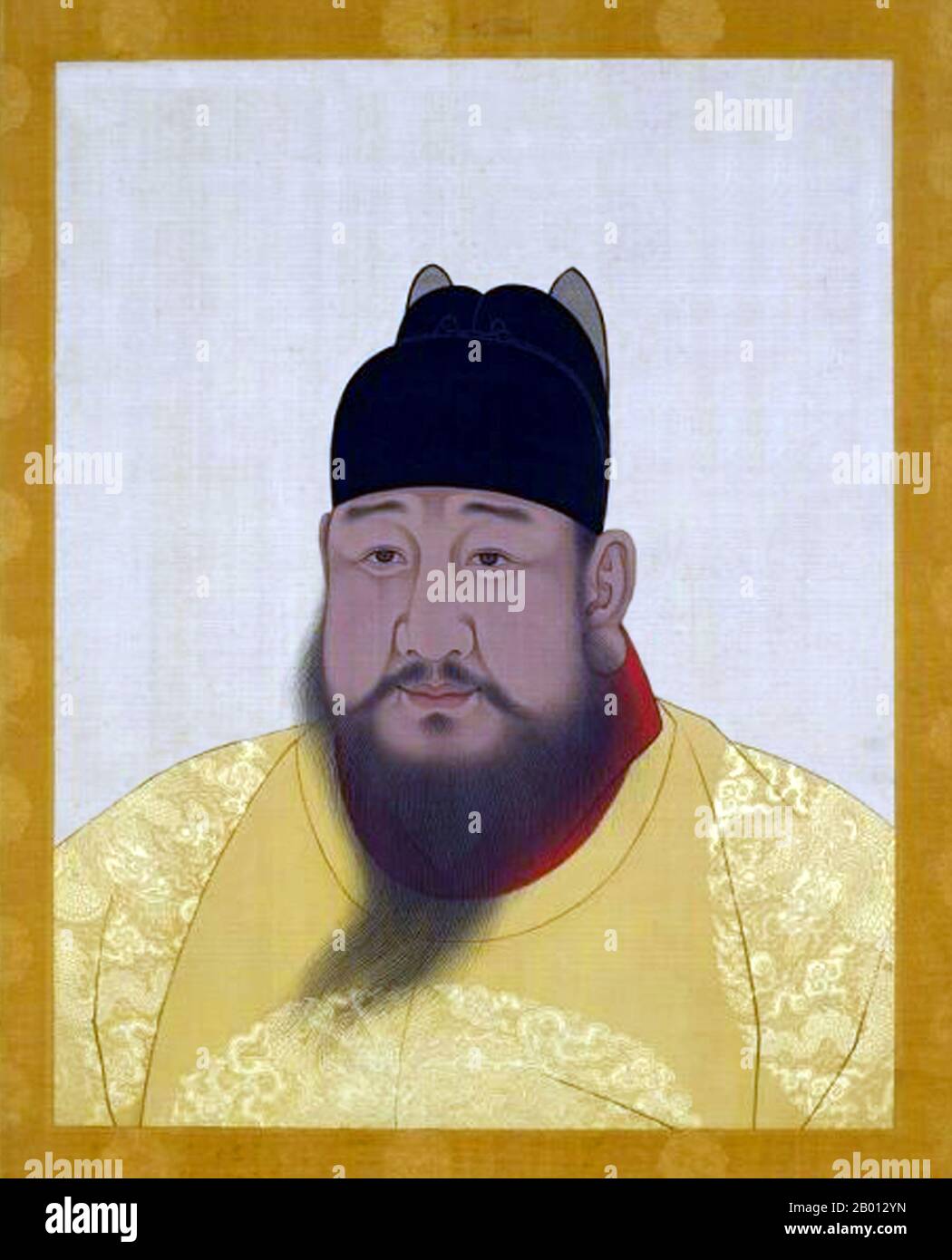 China: Emperor Xuande, 5th ruler of the Ming Dynasty (r. 1425-1435). Hanging scroll painting, 15th-17th century. The Xuande Emperor (1399-1435), personal name Zhu Zhani and temple name Xuanzong, was the 5th emperor of Ming China. His era name means 'Proclamation of Virtue'. The Xuande Emperor ruled over a remarkably peaceful time with no significant external or internal problems. Later historians have considered his reign to be the Ming dynasty's golden age. Stock Photohttps://www.alamy.com/image-license-details/?v=1https://www.alamy.com/china-emperor-xuande-5th-ruler-of-the-ming-dynasty-r-1425-1435-hanging-scroll-painting-15th-17th-century-the-xuande-emperor-1399-1435-personal-name-zhu-zhani-and-temple-name-xuanzong-was-the-5th-emperor-of-ming-china-his-era-name-means-proclamation-of-virtue-the-xuande-emperor-ruled-over-a-remarkably-peaceful-time-with-no-significant-external-or-internal-problems-later-historians-have-considered-his-reign-to-be-the-ming-dynastys-golden-age-image344231657.html
China: Emperor Xuande, 5th ruler of the Ming Dynasty (r. 1425-1435). Hanging scroll painting, 15th-17th century. The Xuande Emperor (1399-1435), personal name Zhu Zhani and temple name Xuanzong, was the 5th emperor of Ming China. His era name means 'Proclamation of Virtue'. The Xuande Emperor ruled over a remarkably peaceful time with no significant external or internal problems. Later historians have considered his reign to be the Ming dynasty's golden age. Stock Photohttps://www.alamy.com/image-license-details/?v=1https://www.alamy.com/china-emperor-xuande-5th-ruler-of-the-ming-dynasty-r-1425-1435-hanging-scroll-painting-15th-17th-century-the-xuande-emperor-1399-1435-personal-name-zhu-zhani-and-temple-name-xuanzong-was-the-5th-emperor-of-ming-china-his-era-name-means-proclamation-of-virtue-the-xuande-emperor-ruled-over-a-remarkably-peaceful-time-with-no-significant-external-or-internal-problems-later-historians-have-considered-his-reign-to-be-the-ming-dynastys-golden-age-image344231657.htmlRM2B012YN–China: Emperor Xuande, 5th ruler of the Ming Dynasty (r. 1425-1435). Hanging scroll painting, 15th-17th century. The Xuande Emperor (1399-1435), personal name Zhu Zhani and temple name Xuanzong, was the 5th emperor of Ming China. His era name means 'Proclamation of Virtue'. The Xuande Emperor ruled over a remarkably peaceful time with no significant external or internal problems. Later historians have considered his reign to be the Ming dynasty's golden age.
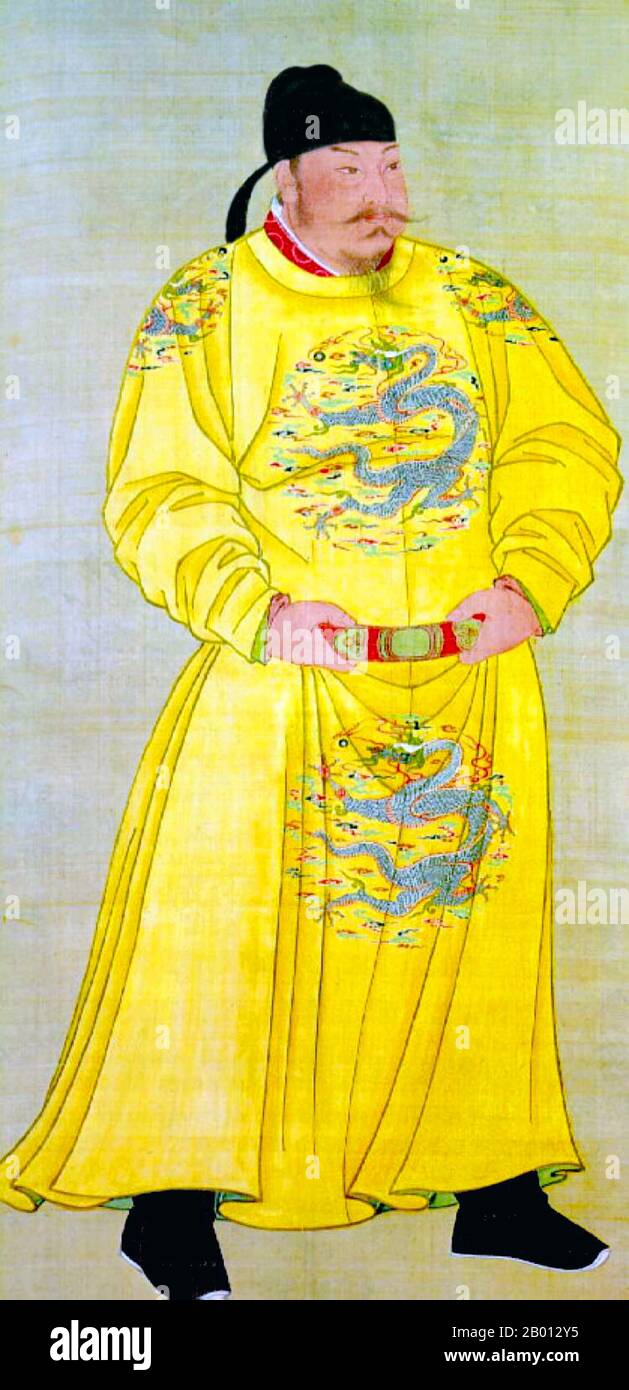 China: Emperor Taizong, 2nd ruler of the Tang Dynasty (r. 626-649). Hanging scroll painting, 7th-10th century. Taizong of Tang (28 January 598 - 10 July 649), personal name Li Shimin, temple name Taizong and previously known as the Prince of Qin, was the second emperor of the Tang Dynasty. Traditionally regarded as a co-founder alongside his father Li Yuan, he played a pivotal role in overthrowing the Sui Dynasty and solidifying his dynasty's ruler over China. Taizong is considered one of the greatest emperors in Chinese history, his reign seen as a golden age and a model for future emperors. Stock Photohttps://www.alamy.com/image-license-details/?v=1https://www.alamy.com/china-emperor-taizong-2nd-ruler-of-the-tang-dynasty-r-626-649-hanging-scroll-painting-7th-10th-century-taizong-of-tang-28-january-598-10-july-649-personal-name-li-shimin-temple-name-taizong-and-previously-known-as-the-prince-of-qin-was-the-second-emperor-of-the-tang-dynasty-traditionally-regarded-as-a-co-founder-alongside-his-father-li-yuan-he-played-a-pivotal-role-in-overthrowing-the-sui-dynasty-and-solidifying-his-dynastys-ruler-over-china-taizong-is-considered-one-of-the-greatest-emperors-in-chinese-history-his-reign-seen-as-a-golden-age-and-a-model-for-future-emperors-image344231641.html
China: Emperor Taizong, 2nd ruler of the Tang Dynasty (r. 626-649). Hanging scroll painting, 7th-10th century. Taizong of Tang (28 January 598 - 10 July 649), personal name Li Shimin, temple name Taizong and previously known as the Prince of Qin, was the second emperor of the Tang Dynasty. Traditionally regarded as a co-founder alongside his father Li Yuan, he played a pivotal role in overthrowing the Sui Dynasty and solidifying his dynasty's ruler over China. Taizong is considered one of the greatest emperors in Chinese history, his reign seen as a golden age and a model for future emperors. Stock Photohttps://www.alamy.com/image-license-details/?v=1https://www.alamy.com/china-emperor-taizong-2nd-ruler-of-the-tang-dynasty-r-626-649-hanging-scroll-painting-7th-10th-century-taizong-of-tang-28-january-598-10-july-649-personal-name-li-shimin-temple-name-taizong-and-previously-known-as-the-prince-of-qin-was-the-second-emperor-of-the-tang-dynasty-traditionally-regarded-as-a-co-founder-alongside-his-father-li-yuan-he-played-a-pivotal-role-in-overthrowing-the-sui-dynasty-and-solidifying-his-dynastys-ruler-over-china-taizong-is-considered-one-of-the-greatest-emperors-in-chinese-history-his-reign-seen-as-a-golden-age-and-a-model-for-future-emperors-image344231641.htmlRM2B012Y5–China: Emperor Taizong, 2nd ruler of the Tang Dynasty (r. 626-649). Hanging scroll painting, 7th-10th century. Taizong of Tang (28 January 598 - 10 July 649), personal name Li Shimin, temple name Taizong and previously known as the Prince of Qin, was the second emperor of the Tang Dynasty. Traditionally regarded as a co-founder alongside his father Li Yuan, he played a pivotal role in overthrowing the Sui Dynasty and solidifying his dynasty's ruler over China. Taizong is considered one of the greatest emperors in Chinese history, his reign seen as a golden age and a model for future emperors.
 China: Emperor Xuande, 5th ruler of the Ming Dynasty (r. 1425-1435), hunting with bow and arrow. Handscroll painting, c. 1425-1435. The Xuande Emperor (1399-1435), personal name Zhu Zhani and temple name Xuanzong, was the 5th emperor of Ming China. His era name means 'Proclamation of Virtue'. The Xuande Emperor ruled over a remarkably peaceful time with no significant external or internal problems. Later historians have considered his reign to be the Ming dynasty's golden age. Stock Photohttps://www.alamy.com/image-license-details/?v=1https://www.alamy.com/china-emperor-xuande-5th-ruler-of-the-ming-dynasty-r-1425-1435-hunting-with-bow-and-arrow-handscroll-painting-c-1425-1435-the-xuande-emperor-1399-1435-personal-name-zhu-zhani-and-temple-name-xuanzong-was-the-5th-emperor-of-ming-china-his-era-name-means-proclamation-of-virtue-the-xuande-emperor-ruled-over-a-remarkably-peaceful-time-with-no-significant-external-or-internal-problems-later-historians-have-considered-his-reign-to-be-the-ming-dynastys-golden-age-image344231659.html
China: Emperor Xuande, 5th ruler of the Ming Dynasty (r. 1425-1435), hunting with bow and arrow. Handscroll painting, c. 1425-1435. The Xuande Emperor (1399-1435), personal name Zhu Zhani and temple name Xuanzong, was the 5th emperor of Ming China. His era name means 'Proclamation of Virtue'. The Xuande Emperor ruled over a remarkably peaceful time with no significant external or internal problems. Later historians have considered his reign to be the Ming dynasty's golden age. Stock Photohttps://www.alamy.com/image-license-details/?v=1https://www.alamy.com/china-emperor-xuande-5th-ruler-of-the-ming-dynasty-r-1425-1435-hunting-with-bow-and-arrow-handscroll-painting-c-1425-1435-the-xuande-emperor-1399-1435-personal-name-zhu-zhani-and-temple-name-xuanzong-was-the-5th-emperor-of-ming-china-his-era-name-means-proclamation-of-virtue-the-xuande-emperor-ruled-over-a-remarkably-peaceful-time-with-no-significant-external-or-internal-problems-later-historians-have-considered-his-reign-to-be-the-ming-dynastys-golden-age-image344231659.htmlRM2B012YR–China: Emperor Xuande, 5th ruler of the Ming Dynasty (r. 1425-1435), hunting with bow and arrow. Handscroll painting, c. 1425-1435. The Xuande Emperor (1399-1435), personal name Zhu Zhani and temple name Xuanzong, was the 5th emperor of Ming China. His era name means 'Proclamation of Virtue'. The Xuande Emperor ruled over a remarkably peaceful time with no significant external or internal problems. Later historians have considered his reign to be the Ming dynasty's golden age.
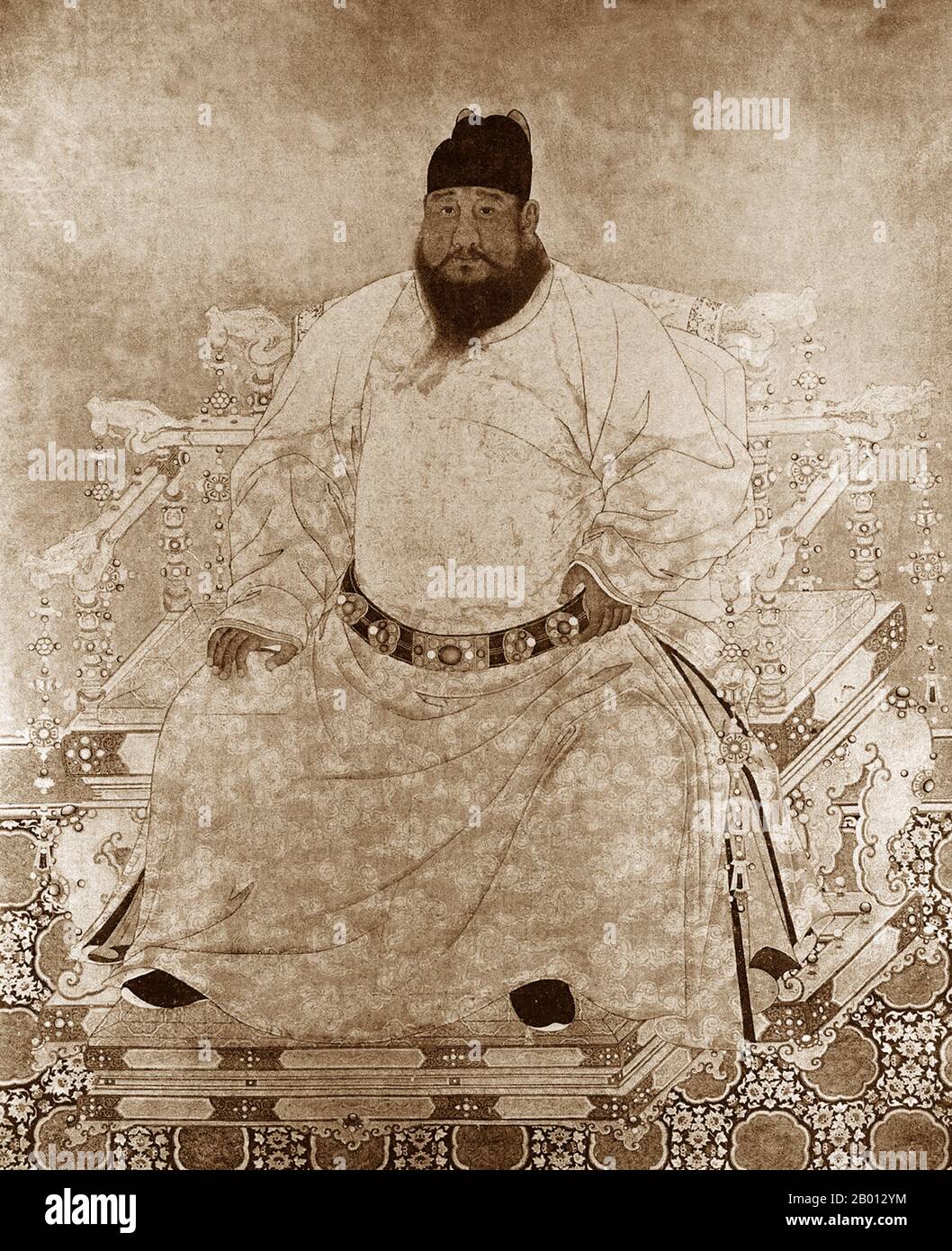 China: Emperor Xuande, 5th ruler of the Ming Dynasty (r. 1425-1435). Hanging scroll painting, 15th-17th century. The Xuande Emperor (1399-1435), personal name Zhu Zhani and temple name Xuanzong, was the 5th emperor of Ming China. His era name means 'Proclamation of Virtue'. The Xuande Emperor ruled over a remarkably peaceful time with no significant external or internal problems. Later historians have considered his reign to be the Ming dynasty's golden age. Stock Photohttps://www.alamy.com/image-license-details/?v=1https://www.alamy.com/china-emperor-xuande-5th-ruler-of-the-ming-dynasty-r-1425-1435-hanging-scroll-painting-15th-17th-century-the-xuande-emperor-1399-1435-personal-name-zhu-zhani-and-temple-name-xuanzong-was-the-5th-emperor-of-ming-china-his-era-name-means-proclamation-of-virtue-the-xuande-emperor-ruled-over-a-remarkably-peaceful-time-with-no-significant-external-or-internal-problems-later-historians-have-considered-his-reign-to-be-the-ming-dynastys-golden-age-image344231656.html
China: Emperor Xuande, 5th ruler of the Ming Dynasty (r. 1425-1435). Hanging scroll painting, 15th-17th century. The Xuande Emperor (1399-1435), personal name Zhu Zhani and temple name Xuanzong, was the 5th emperor of Ming China. His era name means 'Proclamation of Virtue'. The Xuande Emperor ruled over a remarkably peaceful time with no significant external or internal problems. Later historians have considered his reign to be the Ming dynasty's golden age. Stock Photohttps://www.alamy.com/image-license-details/?v=1https://www.alamy.com/china-emperor-xuande-5th-ruler-of-the-ming-dynasty-r-1425-1435-hanging-scroll-painting-15th-17th-century-the-xuande-emperor-1399-1435-personal-name-zhu-zhani-and-temple-name-xuanzong-was-the-5th-emperor-of-ming-china-his-era-name-means-proclamation-of-virtue-the-xuande-emperor-ruled-over-a-remarkably-peaceful-time-with-no-significant-external-or-internal-problems-later-historians-have-considered-his-reign-to-be-the-ming-dynastys-golden-age-image344231656.htmlRM2B012YM–China: Emperor Xuande, 5th ruler of the Ming Dynasty (r. 1425-1435). Hanging scroll painting, 15th-17th century. The Xuande Emperor (1399-1435), personal name Zhu Zhani and temple name Xuanzong, was the 5th emperor of Ming China. His era name means 'Proclamation of Virtue'. The Xuande Emperor ruled over a remarkably peaceful time with no significant external or internal problems. Later historians have considered his reign to be the Ming dynasty's golden age.
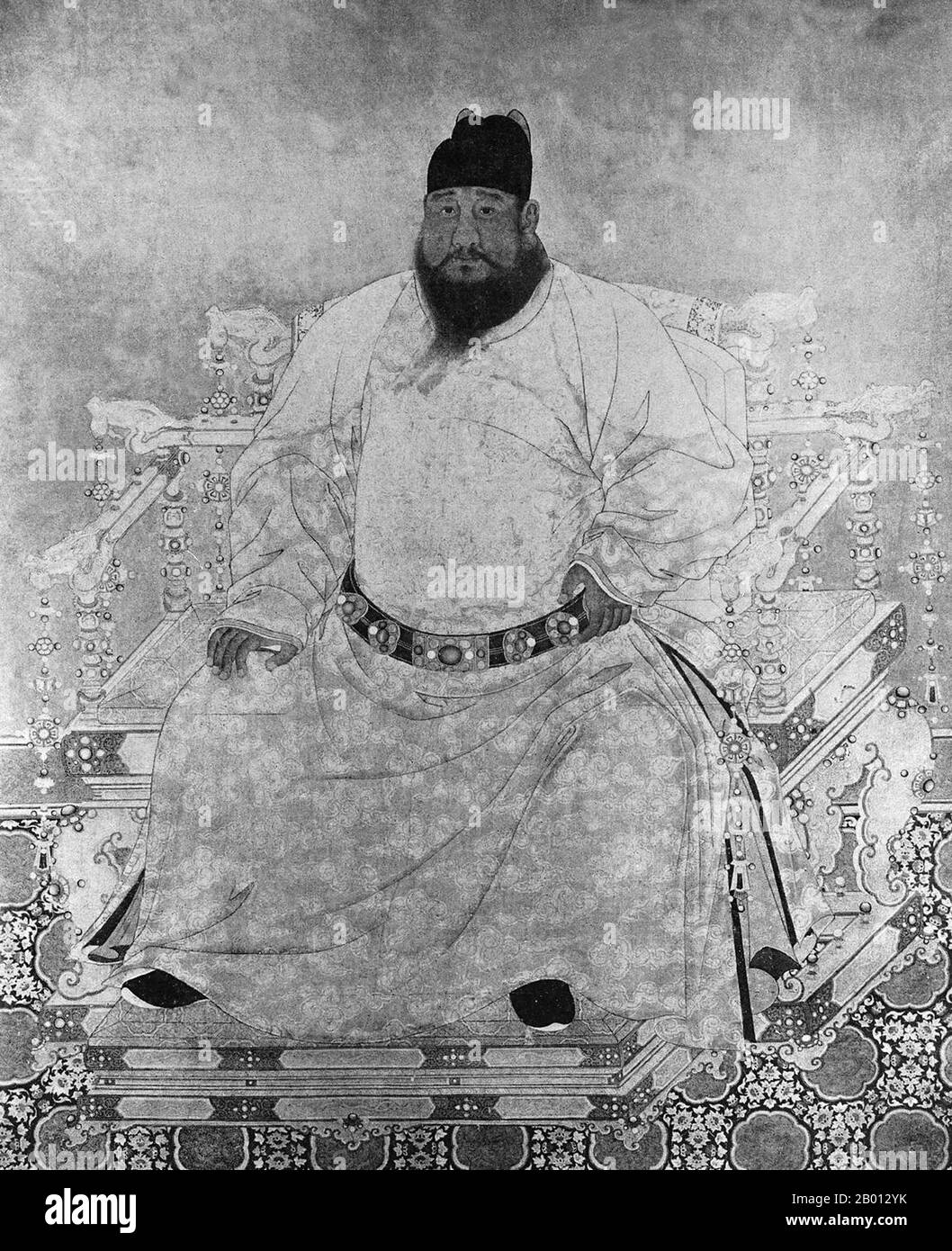 China: Emperor Xuande, 5th ruler of the Ming Dynasty (r. 1425-1435). Hanging scroll painting, 15th-17th century. The Xuande Emperor (1399-1435), personal name Zhu Zhani and temple name Xuanzong, was the 5th emperor of Ming China. His era name means 'Proclamation of Virtue'. The Xuande Emperor ruled over a remarkably peaceful time with no significant external or internal problems. Later historians have considered his reign to be the Ming dynasty's golden age. Stock Photohttps://www.alamy.com/image-license-details/?v=1https://www.alamy.com/china-emperor-xuande-5th-ruler-of-the-ming-dynasty-r-1425-1435-hanging-scroll-painting-15th-17th-century-the-xuande-emperor-1399-1435-personal-name-zhu-zhani-and-temple-name-xuanzong-was-the-5th-emperor-of-ming-china-his-era-name-means-proclamation-of-virtue-the-xuande-emperor-ruled-over-a-remarkably-peaceful-time-with-no-significant-external-or-internal-problems-later-historians-have-considered-his-reign-to-be-the-ming-dynastys-golden-age-image344231655.html
China: Emperor Xuande, 5th ruler of the Ming Dynasty (r. 1425-1435). Hanging scroll painting, 15th-17th century. The Xuande Emperor (1399-1435), personal name Zhu Zhani and temple name Xuanzong, was the 5th emperor of Ming China. His era name means 'Proclamation of Virtue'. The Xuande Emperor ruled over a remarkably peaceful time with no significant external or internal problems. Later historians have considered his reign to be the Ming dynasty's golden age. Stock Photohttps://www.alamy.com/image-license-details/?v=1https://www.alamy.com/china-emperor-xuande-5th-ruler-of-the-ming-dynasty-r-1425-1435-hanging-scroll-painting-15th-17th-century-the-xuande-emperor-1399-1435-personal-name-zhu-zhani-and-temple-name-xuanzong-was-the-5th-emperor-of-ming-china-his-era-name-means-proclamation-of-virtue-the-xuande-emperor-ruled-over-a-remarkably-peaceful-time-with-no-significant-external-or-internal-problems-later-historians-have-considered-his-reign-to-be-the-ming-dynastys-golden-age-image344231655.htmlRM2B012YK–China: Emperor Xuande, 5th ruler of the Ming Dynasty (r. 1425-1435). Hanging scroll painting, 15th-17th century. The Xuande Emperor (1399-1435), personal name Zhu Zhani and temple name Xuanzong, was the 5th emperor of Ming China. His era name means 'Proclamation of Virtue'. The Xuande Emperor ruled over a remarkably peaceful time with no significant external or internal problems. Later historians have considered his reign to be the Ming dynasty's golden age.
 China: 'Emperor Taizong gives an Audience to Ludongzan, the Ambassador of Tibet'. Handscroll painting by Yan Liben (600-673), 641 CE. Emperor Taizong of Tang (January 23, 599 – July 10, 649), personal name Li Shimin, was the second emperor of the Tang Dynasty of China, ruling from 626 to 649. He is ceremonially regarded as a co-founder of the dynasty along with Emperor Gaozu. He is typically considered one of the greatest, if not the greatest, emperors in Chinese history, his reign regarded as the exemplary model against which all others were measured. His era was considered a Golden Age. Stock Photohttps://www.alamy.com/image-license-details/?v=1https://www.alamy.com/china-emperor-taizong-gives-an-audience-to-ludongzan-the-ambassador-of-tibet-handscroll-painting-by-yan-liben-600-673-641-ce-emperor-taizong-of-tang-january-23-599-july-10-649-personal-name-li-shimin-was-the-second-emperor-of-the-tang-dynasty-of-china-ruling-from-626-to-649-he-is-ceremonially-regarded-as-a-co-founder-of-the-dynasty-along-with-emperor-gaozu-he-is-typically-considered-one-of-the-greatest-if-not-the-greatest-emperors-in-chinese-history-his-reign-regarded-as-the-exemplary-model-against-which-all-others-were-measured-his-era-was-considered-a-golden-age-image344231986.html
China: 'Emperor Taizong gives an Audience to Ludongzan, the Ambassador of Tibet'. Handscroll painting by Yan Liben (600-673), 641 CE. Emperor Taizong of Tang (January 23, 599 – July 10, 649), personal name Li Shimin, was the second emperor of the Tang Dynasty of China, ruling from 626 to 649. He is ceremonially regarded as a co-founder of the dynasty along with Emperor Gaozu. He is typically considered one of the greatest, if not the greatest, emperors in Chinese history, his reign regarded as the exemplary model against which all others were measured. His era was considered a Golden Age. Stock Photohttps://www.alamy.com/image-license-details/?v=1https://www.alamy.com/china-emperor-taizong-gives-an-audience-to-ludongzan-the-ambassador-of-tibet-handscroll-painting-by-yan-liben-600-673-641-ce-emperor-taizong-of-tang-january-23-599-july-10-649-personal-name-li-shimin-was-the-second-emperor-of-the-tang-dynasty-of-china-ruling-from-626-to-649-he-is-ceremonially-regarded-as-a-co-founder-of-the-dynasty-along-with-emperor-gaozu-he-is-typically-considered-one-of-the-greatest-if-not-the-greatest-emperors-in-chinese-history-his-reign-regarded-as-the-exemplary-model-against-which-all-others-were-measured-his-era-was-considered-a-golden-age-image344231986.htmlRM2B013BE–China: 'Emperor Taizong gives an Audience to Ludongzan, the Ambassador of Tibet'. Handscroll painting by Yan Liben (600-673), 641 CE. Emperor Taizong of Tang (January 23, 599 – July 10, 649), personal name Li Shimin, was the second emperor of the Tang Dynasty of China, ruling from 626 to 649. He is ceremonially regarded as a co-founder of the dynasty along with Emperor Gaozu. He is typically considered one of the greatest, if not the greatest, emperors in Chinese history, his reign regarded as the exemplary model against which all others were measured. His era was considered a Golden Age.
 China: 'Emperor Taizong gives an Audience to Ludongzan, the Ambassador of Tibet'. Handscroll painting by Yan Liben (600-673), 641 CE. Emperor Taizong of Tang (January 23, 599 – July 10, 649), personal name Li Shimin, was the second emperor of the Tang Dynasty of China, ruling from 626 to 649. He is ceremonially regarded as a co-founder of the dynasty along with Emperor Gaozu. He is typically considered one of the greatest, if not the greatest, emperors in Chinese history, his reign regarded as the exemplary model against which all others were measured. His era was considered a Golden Age. Stock Photohttps://www.alamy.com/image-license-details/?v=1https://www.alamy.com/china-emperor-taizong-gives-an-audience-to-ludongzan-the-ambassador-of-tibet-handscroll-painting-by-yan-liben-600-673-641-ce-emperor-taizong-of-tang-january-23-599-july-10-649-personal-name-li-shimin-was-the-second-emperor-of-the-tang-dynasty-of-china-ruling-from-626-to-649-he-is-ceremonially-regarded-as-a-co-founder-of-the-dynasty-along-with-emperor-gaozu-he-is-typically-considered-one-of-the-greatest-if-not-the-greatest-emperors-in-chinese-history-his-reign-regarded-as-the-exemplary-model-against-which-all-others-were-measured-his-era-was-considered-a-golden-age-image344231988.html
China: 'Emperor Taizong gives an Audience to Ludongzan, the Ambassador of Tibet'. Handscroll painting by Yan Liben (600-673), 641 CE. Emperor Taizong of Tang (January 23, 599 – July 10, 649), personal name Li Shimin, was the second emperor of the Tang Dynasty of China, ruling from 626 to 649. He is ceremonially regarded as a co-founder of the dynasty along with Emperor Gaozu. He is typically considered one of the greatest, if not the greatest, emperors in Chinese history, his reign regarded as the exemplary model against which all others were measured. His era was considered a Golden Age. Stock Photohttps://www.alamy.com/image-license-details/?v=1https://www.alamy.com/china-emperor-taizong-gives-an-audience-to-ludongzan-the-ambassador-of-tibet-handscroll-painting-by-yan-liben-600-673-641-ce-emperor-taizong-of-tang-january-23-599-july-10-649-personal-name-li-shimin-was-the-second-emperor-of-the-tang-dynasty-of-china-ruling-from-626-to-649-he-is-ceremonially-regarded-as-a-co-founder-of-the-dynasty-along-with-emperor-gaozu-he-is-typically-considered-one-of-the-greatest-if-not-the-greatest-emperors-in-chinese-history-his-reign-regarded-as-the-exemplary-model-against-which-all-others-were-measured-his-era-was-considered-a-golden-age-image344231988.htmlRM2B013BG–China: 'Emperor Taizong gives an Audience to Ludongzan, the Ambassador of Tibet'. Handscroll painting by Yan Liben (600-673), 641 CE. Emperor Taizong of Tang (January 23, 599 – July 10, 649), personal name Li Shimin, was the second emperor of the Tang Dynasty of China, ruling from 626 to 649. He is ceremonially regarded as a co-founder of the dynasty along with Emperor Gaozu. He is typically considered one of the greatest, if not the greatest, emperors in Chinese history, his reign regarded as the exemplary model against which all others were measured. His era was considered a Golden Age.
 China: 'Emperor Taizong gives an Audience to Ludongzan, the Ambassador of Tibet'. Handscroll painting by Yan Liben (600-673), 641 CE. Emperor Taizong of Tang (January 23, 599 – July 10, 649), personal name Li Shimin, was the second emperor of the Tang Dynasty of China, ruling from 626 to 649. He is ceremonially regarded as a co-founder of the dynasty along with Emperor Gaozu. He is typically considered one of the greatest, if not the greatest, emperors in Chinese history, his reign regarded as the exemplary model against which all others were measured. His era was considered a Golden Age. Stock Photohttps://www.alamy.com/image-license-details/?v=1https://www.alamy.com/china-emperor-taizong-gives-an-audience-to-ludongzan-the-ambassador-of-tibet-handscroll-painting-by-yan-liben-600-673-641-ce-emperor-taizong-of-tang-january-23-599-july-10-649-personal-name-li-shimin-was-the-second-emperor-of-the-tang-dynasty-of-china-ruling-from-626-to-649-he-is-ceremonially-regarded-as-a-co-founder-of-the-dynasty-along-with-emperor-gaozu-he-is-typically-considered-one-of-the-greatest-if-not-the-greatest-emperors-in-chinese-history-his-reign-regarded-as-the-exemplary-model-against-which-all-others-were-measured-his-era-was-considered-a-golden-age-image344231987.html
China: 'Emperor Taizong gives an Audience to Ludongzan, the Ambassador of Tibet'. Handscroll painting by Yan Liben (600-673), 641 CE. Emperor Taizong of Tang (January 23, 599 – July 10, 649), personal name Li Shimin, was the second emperor of the Tang Dynasty of China, ruling from 626 to 649. He is ceremonially regarded as a co-founder of the dynasty along with Emperor Gaozu. He is typically considered one of the greatest, if not the greatest, emperors in Chinese history, his reign regarded as the exemplary model against which all others were measured. His era was considered a Golden Age. Stock Photohttps://www.alamy.com/image-license-details/?v=1https://www.alamy.com/china-emperor-taizong-gives-an-audience-to-ludongzan-the-ambassador-of-tibet-handscroll-painting-by-yan-liben-600-673-641-ce-emperor-taizong-of-tang-january-23-599-july-10-649-personal-name-li-shimin-was-the-second-emperor-of-the-tang-dynasty-of-china-ruling-from-626-to-649-he-is-ceremonially-regarded-as-a-co-founder-of-the-dynasty-along-with-emperor-gaozu-he-is-typically-considered-one-of-the-greatest-if-not-the-greatest-emperors-in-chinese-history-his-reign-regarded-as-the-exemplary-model-against-which-all-others-were-measured-his-era-was-considered-a-golden-age-image344231987.htmlRM2B013BF–China: 'Emperor Taizong gives an Audience to Ludongzan, the Ambassador of Tibet'. Handscroll painting by Yan Liben (600-673), 641 CE. Emperor Taizong of Tang (January 23, 599 – July 10, 649), personal name Li Shimin, was the second emperor of the Tang Dynasty of China, ruling from 626 to 649. He is ceremonially regarded as a co-founder of the dynasty along with Emperor Gaozu. He is typically considered one of the greatest, if not the greatest, emperors in Chinese history, his reign regarded as the exemplary model against which all others were measured. His era was considered a Golden Age.
 China: 'Emperor Taizong gives an Audience to Ludongzan, the Ambassador of Tibet'. Handscroll painting by Yan Liben (600-673), 641 CE. Emperor Taizong of Tang (January 23, 599 – July 10, 649), personal name Li Shimin, was the second emperor of the Tang Dynasty of China, ruling from 626 to 649. He is ceremonially regarded as a co-founder of the dynasty along with Emperor Gaozu. He is typically considered one of the greatest, if not the greatest, emperors in Chinese history, his reign regarded as the exemplary model against which all others were measured. His era was considered a Golden Age. Stock Photohttps://www.alamy.com/image-license-details/?v=1https://www.alamy.com/china-emperor-taizong-gives-an-audience-to-ludongzan-the-ambassador-of-tibet-handscroll-painting-by-yan-liben-600-673-641-ce-emperor-taizong-of-tang-january-23-599-july-10-649-personal-name-li-shimin-was-the-second-emperor-of-the-tang-dynasty-of-china-ruling-from-626-to-649-he-is-ceremonially-regarded-as-a-co-founder-of-the-dynasty-along-with-emperor-gaozu-he-is-typically-considered-one-of-the-greatest-if-not-the-greatest-emperors-in-chinese-history-his-reign-regarded-as-the-exemplary-model-against-which-all-others-were-measured-his-era-was-considered-a-golden-age-image344231989.html
China: 'Emperor Taizong gives an Audience to Ludongzan, the Ambassador of Tibet'. Handscroll painting by Yan Liben (600-673), 641 CE. Emperor Taizong of Tang (January 23, 599 – July 10, 649), personal name Li Shimin, was the second emperor of the Tang Dynasty of China, ruling from 626 to 649. He is ceremonially regarded as a co-founder of the dynasty along with Emperor Gaozu. He is typically considered one of the greatest, if not the greatest, emperors in Chinese history, his reign regarded as the exemplary model against which all others were measured. His era was considered a Golden Age. Stock Photohttps://www.alamy.com/image-license-details/?v=1https://www.alamy.com/china-emperor-taizong-gives-an-audience-to-ludongzan-the-ambassador-of-tibet-handscroll-painting-by-yan-liben-600-673-641-ce-emperor-taizong-of-tang-january-23-599-july-10-649-personal-name-li-shimin-was-the-second-emperor-of-the-tang-dynasty-of-china-ruling-from-626-to-649-he-is-ceremonially-regarded-as-a-co-founder-of-the-dynasty-along-with-emperor-gaozu-he-is-typically-considered-one-of-the-greatest-if-not-the-greatest-emperors-in-chinese-history-his-reign-regarded-as-the-exemplary-model-against-which-all-others-were-measured-his-era-was-considered-a-golden-age-image344231989.htmlRM2B013BH–China: 'Emperor Taizong gives an Audience to Ludongzan, the Ambassador of Tibet'. Handscroll painting by Yan Liben (600-673), 641 CE. Emperor Taizong of Tang (January 23, 599 – July 10, 649), personal name Li Shimin, was the second emperor of the Tang Dynasty of China, ruling from 626 to 649. He is ceremonially regarded as a co-founder of the dynasty along with Emperor Gaozu. He is typically considered one of the greatest, if not the greatest, emperors in Chinese history, his reign regarded as the exemplary model against which all others were measured. His era was considered a Golden Age.
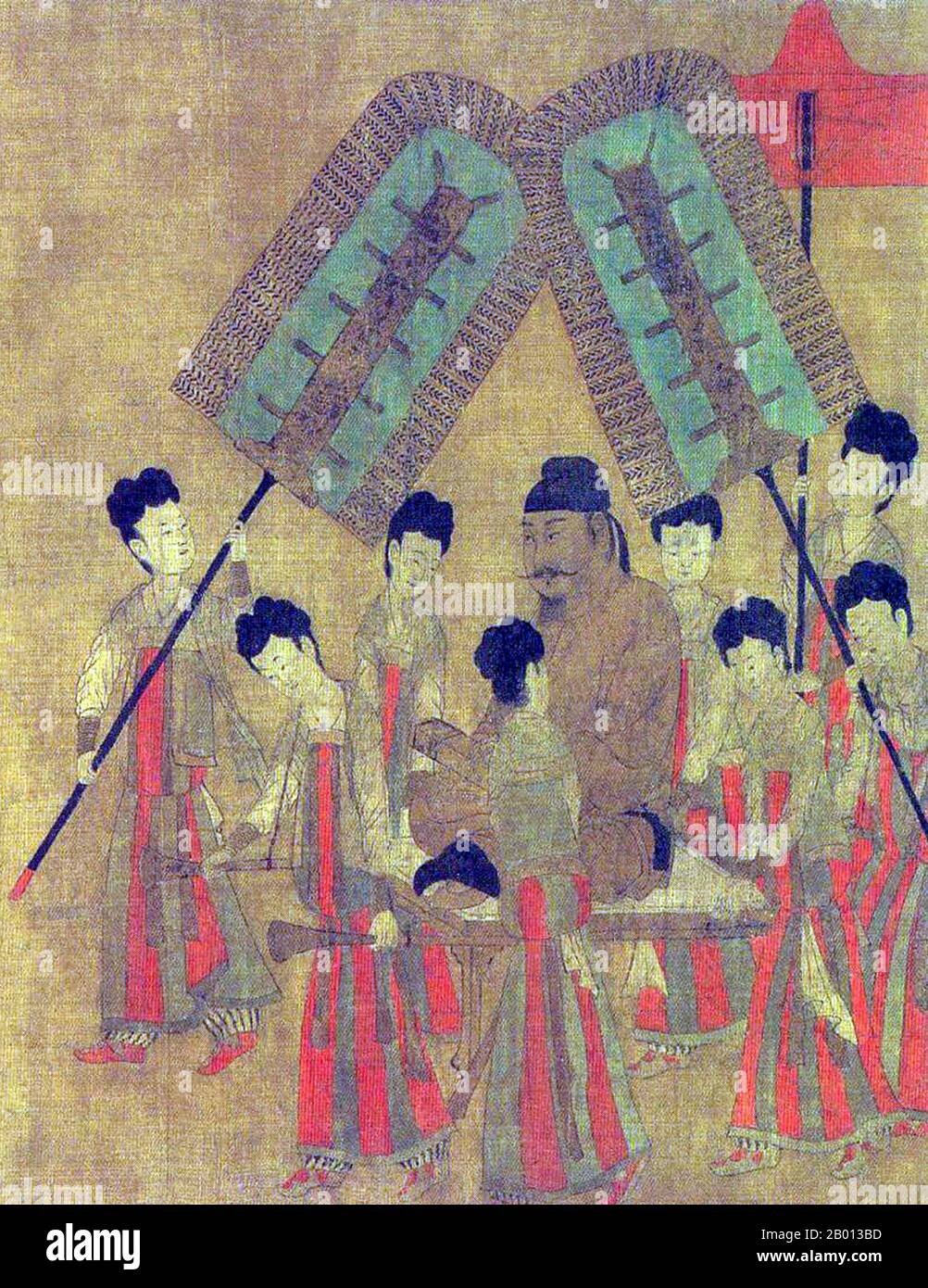 China: 'Emperor Taizong gives an Audience to Ludongzan, the Ambassador of Tibet'. Handscroll painting by Yan Liben (600-673), 641 CE. Emperor Taizong of Tang (January 23, 599 – July 10, 649), personal name Li Shimin, was the second emperor of the Tang Dynasty of China, ruling from 626 to 649. He is ceremonially regarded as a co-founder of the dynasty along with Emperor Gaozu. He is typically considered one of the greatest, if not the greatest, emperors in Chinese history, his reign regarded as the exemplary model against which all others were measured. His era was considered a Golden Age. Stock Photohttps://www.alamy.com/image-license-details/?v=1https://www.alamy.com/china-emperor-taizong-gives-an-audience-to-ludongzan-the-ambassador-of-tibet-handscroll-painting-by-yan-liben-600-673-641-ce-emperor-taizong-of-tang-january-23-599-july-10-649-personal-name-li-shimin-was-the-second-emperor-of-the-tang-dynasty-of-china-ruling-from-626-to-649-he-is-ceremonially-regarded-as-a-co-founder-of-the-dynasty-along-with-emperor-gaozu-he-is-typically-considered-one-of-the-greatest-if-not-the-greatest-emperors-in-chinese-history-his-reign-regarded-as-the-exemplary-model-against-which-all-others-were-measured-his-era-was-considered-a-golden-age-image344231985.html
China: 'Emperor Taizong gives an Audience to Ludongzan, the Ambassador of Tibet'. Handscroll painting by Yan Liben (600-673), 641 CE. Emperor Taizong of Tang (January 23, 599 – July 10, 649), personal name Li Shimin, was the second emperor of the Tang Dynasty of China, ruling from 626 to 649. He is ceremonially regarded as a co-founder of the dynasty along with Emperor Gaozu. He is typically considered one of the greatest, if not the greatest, emperors in Chinese history, his reign regarded as the exemplary model against which all others were measured. His era was considered a Golden Age. Stock Photohttps://www.alamy.com/image-license-details/?v=1https://www.alamy.com/china-emperor-taizong-gives-an-audience-to-ludongzan-the-ambassador-of-tibet-handscroll-painting-by-yan-liben-600-673-641-ce-emperor-taizong-of-tang-january-23-599-july-10-649-personal-name-li-shimin-was-the-second-emperor-of-the-tang-dynasty-of-china-ruling-from-626-to-649-he-is-ceremonially-regarded-as-a-co-founder-of-the-dynasty-along-with-emperor-gaozu-he-is-typically-considered-one-of-the-greatest-if-not-the-greatest-emperors-in-chinese-history-his-reign-regarded-as-the-exemplary-model-against-which-all-others-were-measured-his-era-was-considered-a-golden-age-image344231985.htmlRM2B013BD–China: 'Emperor Taizong gives an Audience to Ludongzan, the Ambassador of Tibet'. Handscroll painting by Yan Liben (600-673), 641 CE. Emperor Taizong of Tang (January 23, 599 – July 10, 649), personal name Li Shimin, was the second emperor of the Tang Dynasty of China, ruling from 626 to 649. He is ceremonially regarded as a co-founder of the dynasty along with Emperor Gaozu. He is typically considered one of the greatest, if not the greatest, emperors in Chinese history, his reign regarded as the exemplary model against which all others were measured. His era was considered a Golden Age.
 China: 'Emperor Taizong gives an Audience to Ludongzan, the Ambassador of Tibet'. Handscroll painting by Yan Liben (600-673), 641 CE. Emperor Taizong of Tang (January 23, 599 – July 10, 649), personal name Li Shimin, was the second emperor of the Tang Dynasty of China, ruling from 626 to 649. He is ceremonially regarded as a co-founder of the dynasty along with Emperor Gaozu. He is typically considered one of the greatest, if not the greatest, emperors in Chinese history, his reign regarded as the exemplary model against which all others were measured. His era was considered a Golden Age. Stock Photohttps://www.alamy.com/image-license-details/?v=1https://www.alamy.com/china-emperor-taizong-gives-an-audience-to-ludongzan-the-ambassador-of-tibet-handscroll-painting-by-yan-liben-600-673-641-ce-emperor-taizong-of-tang-january-23-599-july-10-649-personal-name-li-shimin-was-the-second-emperor-of-the-tang-dynasty-of-china-ruling-from-626-to-649-he-is-ceremonially-regarded-as-a-co-founder-of-the-dynasty-along-with-emperor-gaozu-he-is-typically-considered-one-of-the-greatest-if-not-the-greatest-emperors-in-chinese-history-his-reign-regarded-as-the-exemplary-model-against-which-all-others-were-measured-his-era-was-considered-a-golden-age-image344231984.html
China: 'Emperor Taizong gives an Audience to Ludongzan, the Ambassador of Tibet'. Handscroll painting by Yan Liben (600-673), 641 CE. Emperor Taizong of Tang (January 23, 599 – July 10, 649), personal name Li Shimin, was the second emperor of the Tang Dynasty of China, ruling from 626 to 649. He is ceremonially regarded as a co-founder of the dynasty along with Emperor Gaozu. He is typically considered one of the greatest, if not the greatest, emperors in Chinese history, his reign regarded as the exemplary model against which all others were measured. His era was considered a Golden Age. Stock Photohttps://www.alamy.com/image-license-details/?v=1https://www.alamy.com/china-emperor-taizong-gives-an-audience-to-ludongzan-the-ambassador-of-tibet-handscroll-painting-by-yan-liben-600-673-641-ce-emperor-taizong-of-tang-january-23-599-july-10-649-personal-name-li-shimin-was-the-second-emperor-of-the-tang-dynasty-of-china-ruling-from-626-to-649-he-is-ceremonially-regarded-as-a-co-founder-of-the-dynasty-along-with-emperor-gaozu-he-is-typically-considered-one-of-the-greatest-if-not-the-greatest-emperors-in-chinese-history-his-reign-regarded-as-the-exemplary-model-against-which-all-others-were-measured-his-era-was-considered-a-golden-age-image344231984.htmlRM2B013BC–China: 'Emperor Taizong gives an Audience to Ludongzan, the Ambassador of Tibet'. Handscroll painting by Yan Liben (600-673), 641 CE. Emperor Taizong of Tang (January 23, 599 – July 10, 649), personal name Li Shimin, was the second emperor of the Tang Dynasty of China, ruling from 626 to 649. He is ceremonially regarded as a co-founder of the dynasty along with Emperor Gaozu. He is typically considered one of the greatest, if not the greatest, emperors in Chinese history, his reign regarded as the exemplary model against which all others were measured. His era was considered a Golden Age.